Are you an educator or a trainer?
You can use these images as postcards to spark discussions, guide reflections, build scenarios, and inspire brainstorming.
Images have a unique power in education: they do not simply transmit information, but invite interpretation. Their openness allows learners to project ideas, emotions, and associations, creating fertile ground for dialogue and critical thinking.
In a context where technologies such as AI and data are rapidly reshaping our societies, working with imagery can help students and trainees move beyond ready-made answers. An image can raise questions, challenge assumptions, and stimulate ethical reflection in ways that a straightforward text or lecture often cannot.
For educators, these visual materials offer an opportunity to design activities that connect imagination with analysis, encouraging learners to explore multiple perspectives on the role of technology in education and beyond.
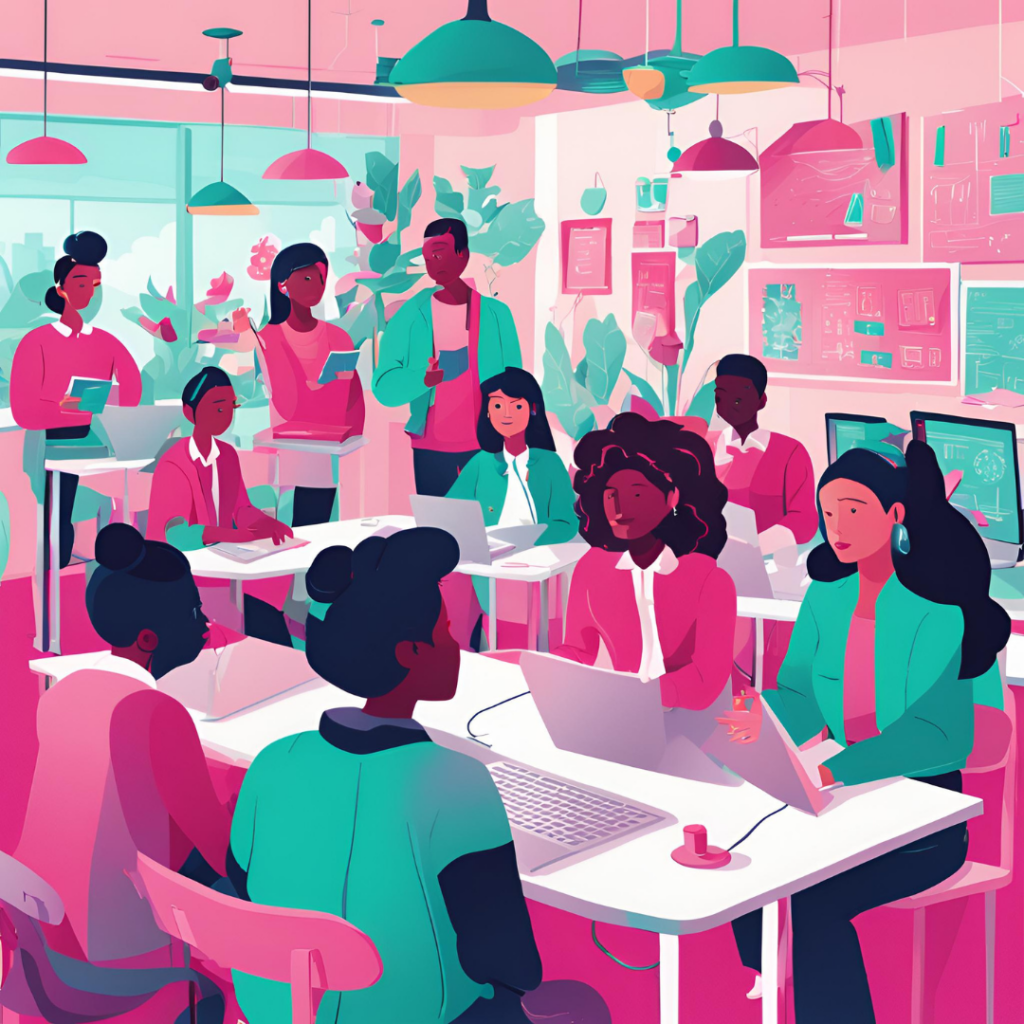
Here we present the works of the three contest winners, each offering a unique perspective on ethics and technology through visual storytelling.
Paula Delgado Hernández
Student, University of La Laguna (Spain)
Educating with Ethics: Visualizing Dilemmas of the Digital World
Description
This proposal is based on the conceptual framework of the Eth-Tech Perspective, which invites reflection on the relationship between ethics, technology and education from a critical, situated and transformative perspective. The main objective was to visualize the 10 key concepts of the framework in a series of illustrated cards that serve as pedagogical tools to facilitate dialogue, imagination and ethical action in educational contexts. Each card was designed as a symbolic scene that translates philosophical ideas into accessible visual metaphors. To achieve this, the artificial intelligence image generation tool PicLumen was used, combining precise prompts in English with an artistic approach that prioritizes cultural diversity, ecological connection, social justice and critical imagination. The creative process included a phase of deep reading of concepts, mental sketching, writing detailed prompts and multiple tests until a coherent aesthetic was achieved: digital, warm, poetic and critical. Each image was selected not only for its beauty, but for its ability to open up ethical and emotional questions. Special care was taken to ensure a diverse representation of bodies, cultures, ages and environments. These cards are intended to function as visual triggers in classrooms, workshops and educational spaces, where learning about technology also means imagining how to transform it.
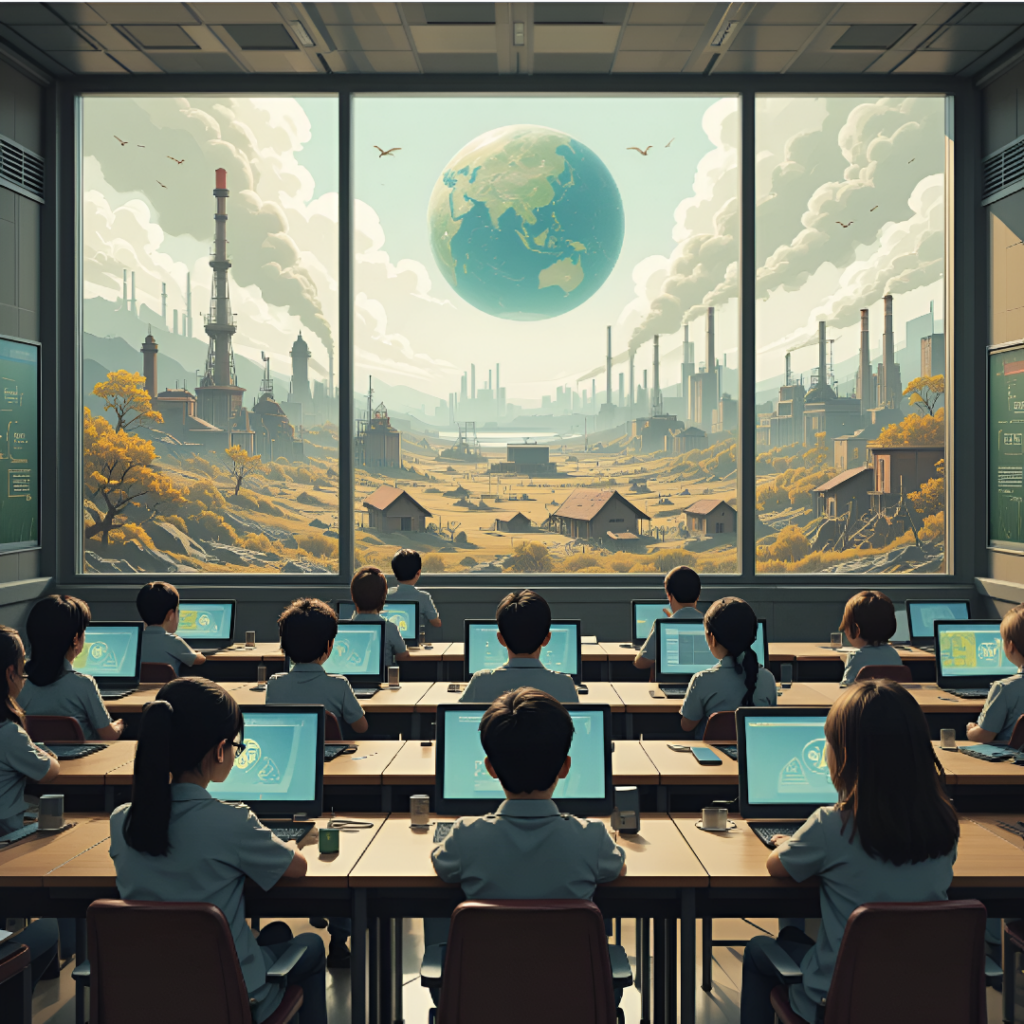
Planetary Ruins
Classroom in Ruins: Learning in the Footsteps of Progress
This image represents the concept of Planetary Ruins, a critical metaphor that denounces the destructive effects of uncontrolled technological progress. The scene shows a modern classroom where children use artificial intelligence to learn about respect for the environment. However, the contradiction becomes visible through the window: outside the classroom, a landscape devastated by climate change, deforestation and ecological collapse unfolds. This representation underscores the paradox of teaching sustainability using tools whose indiscriminate production and use can contribute to the very deterioration we are trying to avoid. It invites reflection on the need for truly sustainable technologies, integrated with an ethic of planetary care.
A description of the creative process:
This image was created using a generative artificial intelligence tool (PicLumen). The goal was to visually illustrate the contrast between a seemingly advanced educational environment and the environmental consequences of the massive and unregulated use of technology.
It began by defining the ethical and visual approach: to depict a modern classroom with children using artificial intelligence to learn about ecology, but set within a deteriorated outside world. The following textual prompt adapted for AI was used:
“A digital illustration of a classroom full of children using artificial intelligence tools while learning about environmental care. Through the window, a devastated landscape is visible: deforestation, polluted skies, collapsed ecosystems. The contrast between the clean, high-tech interior and the ruined nature outside is stark and thought-provoking.”
The AI generated multiple versions of the image, from which the one that best captured the contradiction between ecological learning and visible environmental destruction was selected. This image seeks to trigger a critical reflection on how we use technology, even in educational contexts, and the urgency of aligning it with real sustainability principles.
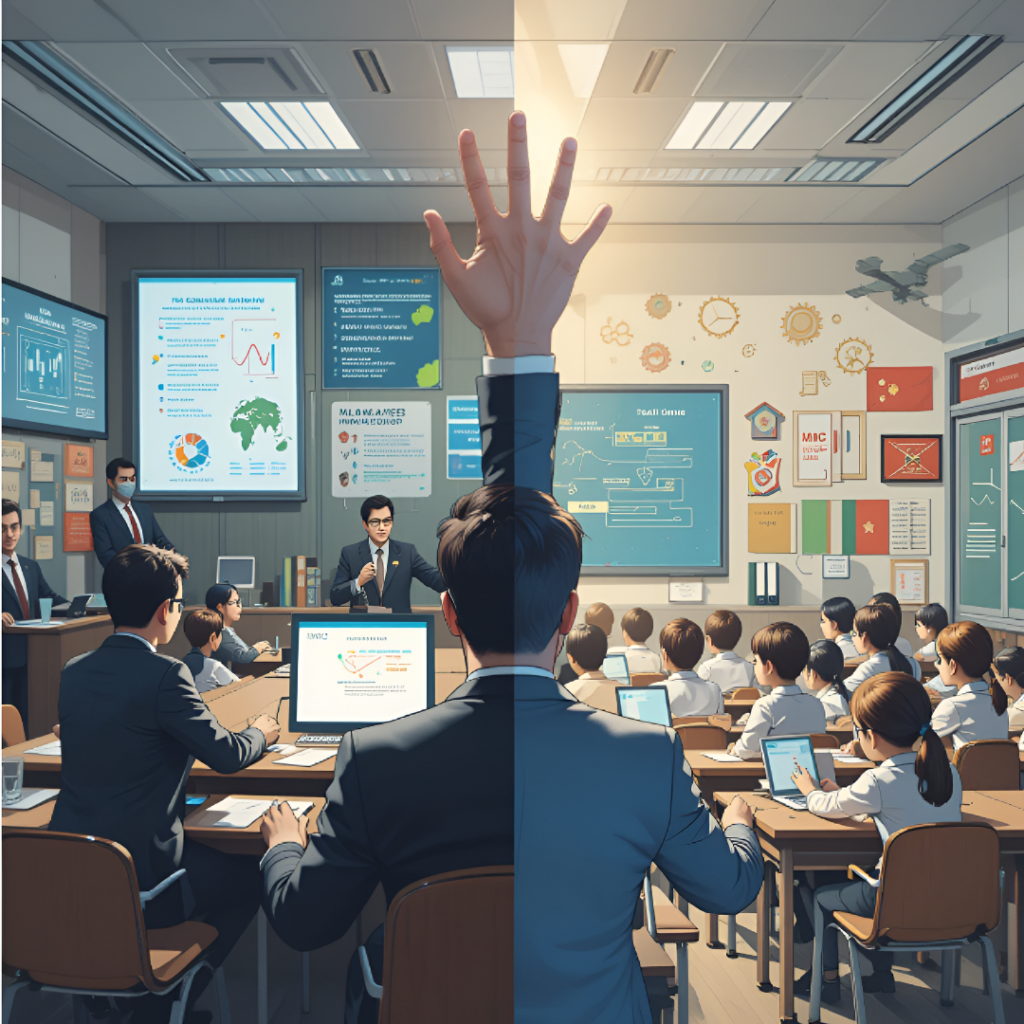
Political power
Invisible Power: Who Controls Digital Education?
The image explores the concept of political power in educational technology, revealing that decisions about which technologies are developed, regulated or implemented are not neutral. In many cases, economic and geopolitical interests profoundly influence what tools are offered to schools and how they are used. While on one side of the corporate world algorithms and contracts are negotiated, in the classroom students passively consume technologies decided by others. This power imbalance raises fundamental ethical questions about educational autonomy, justice and technological sovereignty.
A description of the creative process:
To visually represent this complex concept, the artificial intelligence image generation tool PicLumen was used. The image was designed from a detailed prompt that proposed a composition divided into two halves: a corporate boardroom and a school classroom, reflecting the tension between those who decide and those who use technology.
The prompt used was as follows:
“A conceptual digital illustration divided into two halves: on the left, a corporate boardroom with executives in suits making decisions about educational technology, surrounded by screens displaying algorithms, data charts, and contracts. On the right, a primary school classroom where children use digital tools, while a large invisible hand from above controls the devices. The background includes subtle symbols of political and economic influence like gears, money, satellites, and national flags.”
The AI generated several versions, and the one that best represented the visual metaphor of invisible power was selected. This process not only visualizes an ethical critique, but turns an abstract idea into an accessible and provocative educational tool.

Global Inequality
Two Worlds, One System: The Global Technology Gap
This image visually represents global technological inequality, a phenomenon in which the benefits of innovation are concentrated in the countries of the Global North, while the negative impacts -such as the exploitation of natural resources, electronic waste and labor precariousness- fall on the Global South. Through a contrast between two halves – a rich and technified city versus an impoverished and polluted community – it shows how technological progress is neither neutral nor equitable. This visual card invites us to reflect on the need for a technoglobal justice that promotes a more ethical and supportive distribution of technologies and their consequences.
A description of the creative process:
The illustration was created using PicLumen, an artificial intelligence-based image generation tool. The main objective was to build a powerful visual metaphor for global technological and ecological inequality. To achieve this, a vertically divided composition was devised, in which the left side represents a city of the Global North with high levels of technological development, while the right side shows an impoverished environment of the Global South affected by waste and technological exploitation.
The prompt used was:
“A high-contrast digital illustration divided vertically into two scenes. On the left, a clean, high-tech city of the Global North: skyscrapers, people using advanced technologies (VR, robotics, AI), and a bright, blue sky. On the right, a dusty, impoverished Global South community: children scavenging e-waste, open-pit mines, broken electronics, and grey polluted skies. Strong visual contrast to highlight technological injustice and environmental exploitation.”
PicLumen generated several versions, from which the one that best conveyed the emotional and ethical contrast was chosen. The process sought not only a striking aesthetic, but also a critical pedagogical tool to question the unequal structure of the global technological system.
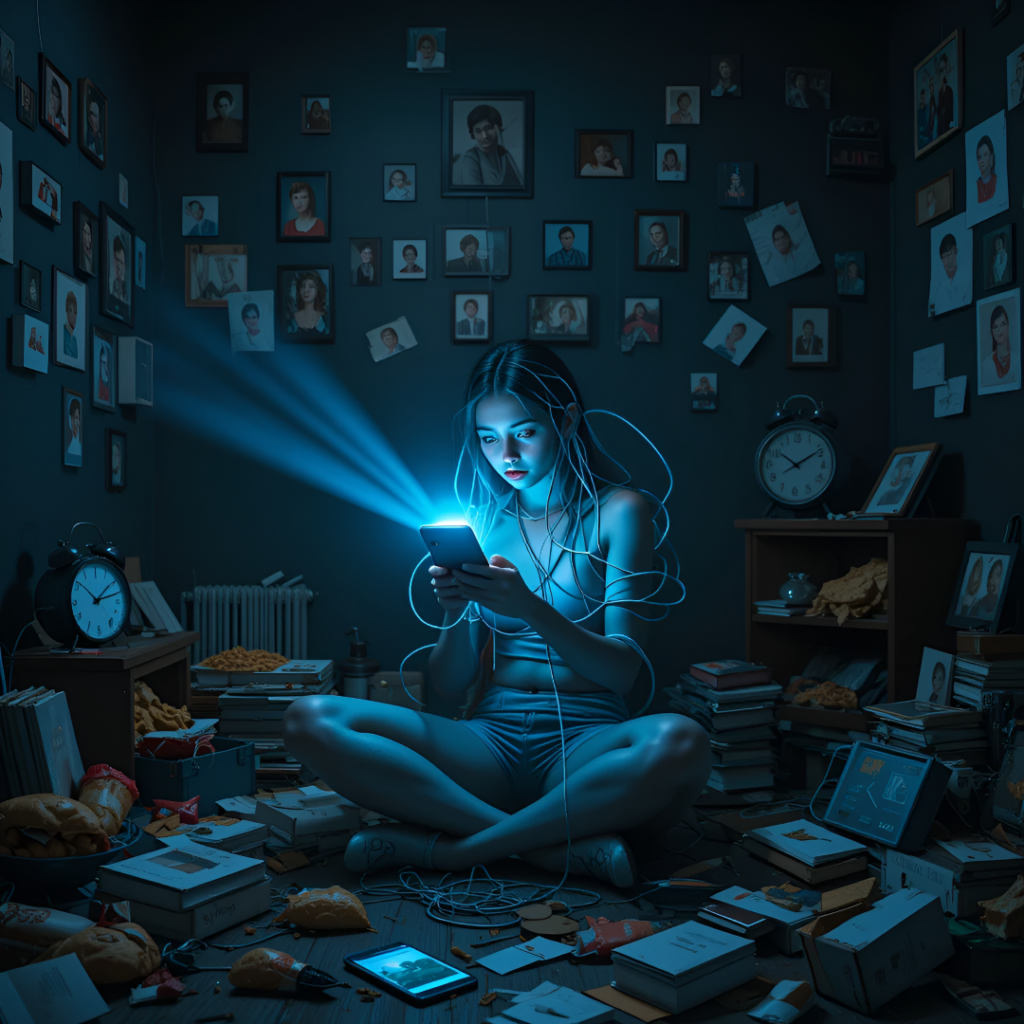
Addiction/Dependency
Connected and Chained: The Digital Addiction Trap
This image represents the emotional and existential impact of technological dependence, particularly in young people. Many technologies are designed to maximize usage time through constant stimuli and addictive mechanisms, such as social networks or video games. This invisible addiction can lead to isolation, loss of meaningful relationships, sleep disturbances and neglect of self-care. The illustration translates these effects into visual symbols: wires that bind the body, physical disorder and digital eyes that watch. The purpose is to invite ethical reflection on how these technologies are designed and at what human and social cost.
A description of the creative process:
The image was created with PicLumen, an artificial intelligence-based digital art generation tool. The creative approach was to build a scene loaded with emotional symbolism, which would allow visualizing the inner experience of technological addiction. A surreal and somber aesthetic was chosen to emphasize the contrast between the artificial light of the device and the emotional darkness surrounding the character.
The prompt used was as follows:
“A dark and symbolic digital illustration of a young person sitting alone in a messy room, staring at a glowing smartphone. Blue light from the screen illuminates their face. Cables or tentacles emerge from the phone and wrap around their body, symbolizing addiction and loss of freedom. Around them: fast food, broken clocks, ignored messages, and fallen family photos, representing neglect and isolation. The walls are covered with social media icons that resemble watching eyes.”
Multiple versions were generated and the one that best expressed the tension between digital connection and emotional disconnection was selected. The process sought not only visual impact, but to provoke empathy and critical awareness, especially among students and teachers.
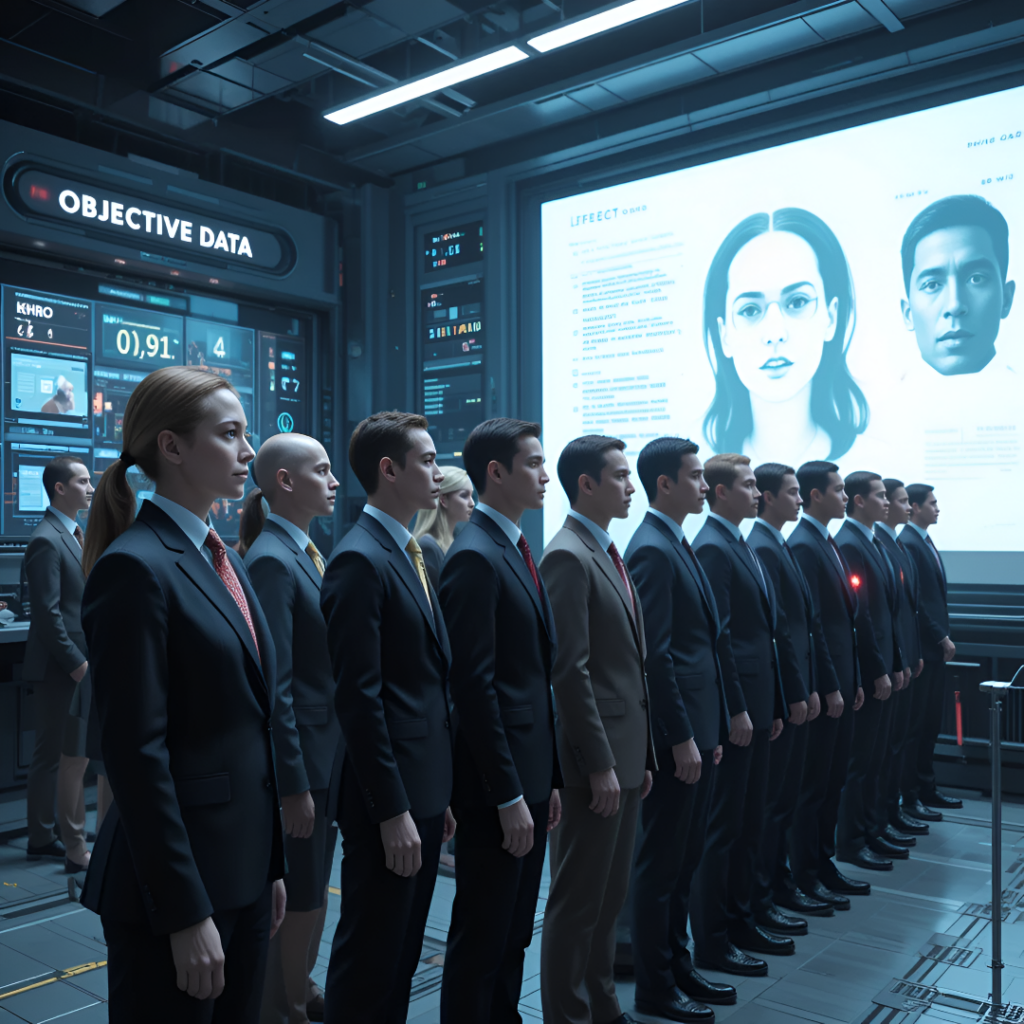
Bias/Discrimination
Algorithms that Decide, Data that Discriminate
Technology is not neutral. Algorithms, especially in artificial intelligence, can reproduce and amplify existing biases in society if they are trained with biased or poorly contextualized data. This image represents a dystopia that is not so far from our reality: a seemingly “objective” AI that discriminates against people based on their race, class or gender. Although automatic systems appear cold and precise, their decisions can be profoundly unjust if they are not designed with an ethical conscience. This visual proposal denounces how the technical can cover up the ethically problematic, and invites us to question who programs, with what data and with what values.
A description of the creative process:
This illustration was generated with PicLumen, using a symbolic narrative approach to represent the effects of algorithmic bias. A futuristic scene was designed in an AI control room, with a dystopian aesthetic that emphasizes the coldness of automated systems. Diverse people – in gender, race and class – are lined up in front of a central machine that decides their fate: some are approved with green lights, while others are marked with red and rejection symbols.
The background includes screens with distorted databases and visible errors, evidence that the data is far from objective. An ironic sign reading “Objective data” reinforces the visual critique. A dark, symbolic digital style was selected to provoke an emotional reaction and critical reflection.
Prompt used in PicLumen (in English to optimize generation):
“Futuristic digital art of a control room where an AI algorithm evaluates people of diverse race, gender and social background. The AI machine approves white, wealthy-looking individuals in suits with green lights, and rejects others with red marks or warning symbols. Background screens show distorted faces, corrupted datasets, and biased code. A sign above reads ‘Objective Data’ in an ironic tone.”
Multiple iterations were generated, and the one that best managed to represent the invisible injustice of systems that present themselves as unbiased was chosen. This card seeks to open up ethical debate in educational contexts about fair and responsible technology design.
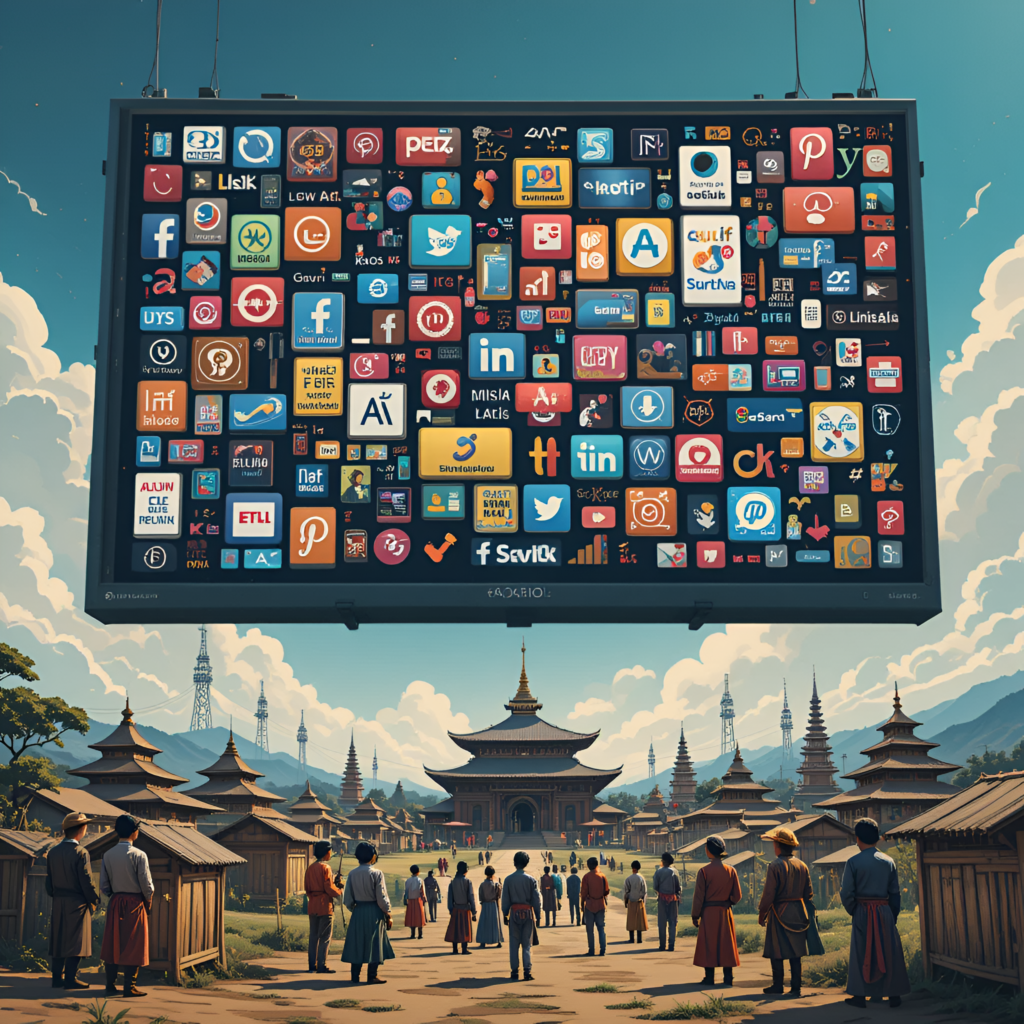
Cultural Impoverishment
Under the Shadow of the Screen
Cultural impoverishment occurs when technology, instead of enriching diversity, imposes a dominant and homogeneous culture on a global scale. This image illustrates how globalized digital content – such as brands, social networks or mass entertainment – can displace local knowledge, traditions and diverse ways of life. Under an omnipresent screen that dominates the sky, unique cultural symbols slowly fade away, giving way to a uniform culture based on digital consumption. This illustration denounces the risk of losing the plurality that gives meaning to human communities. Technological ethics must serve to protect and make these differences visible, not to erase them.
A description of the creative process:
The image was created with the AI image generation tool PicLumen, based on a symbolic and critical visual approach. A composition was proposed where the sky, normally linked to the spiritual or natural, is covered by a gigantic digital screen that projects images of global advertising, social networks and universal influencers. This screen generates a sense of cultural oppression.
Below, in a village of traditional aesthetics, appear people from different cultures (such as indigenous people, artisans or peasants) who observe the projection with uneasiness. Their cultural elements – clothing, books, instruments – fade away or are replaced by standardized technological devices. In addition, temples, markets and community squares are replaced by shopping malls and signal towers.
Prompt used in PicLumen:
“Conceptual digital art. A massive digital screen dominates the sky over a traditional village. The screen displays globalized content: social media icons, brands, influencers. Below, people from diverse cultures (indigenous, rural, artisans) look up in confusion, while their traditional clothing, books, and tools fade away, replaced by identical tech devices. Background changes from temples and markets to shopping malls and signal towers. High contrast between traditional colors and cold digital light.”
Variations were made to balance detail and symbolism. This image is intended to generate discussion in classrooms and educational spaces about the role of technology in the preservation (or erosion) of global cultural diversity.
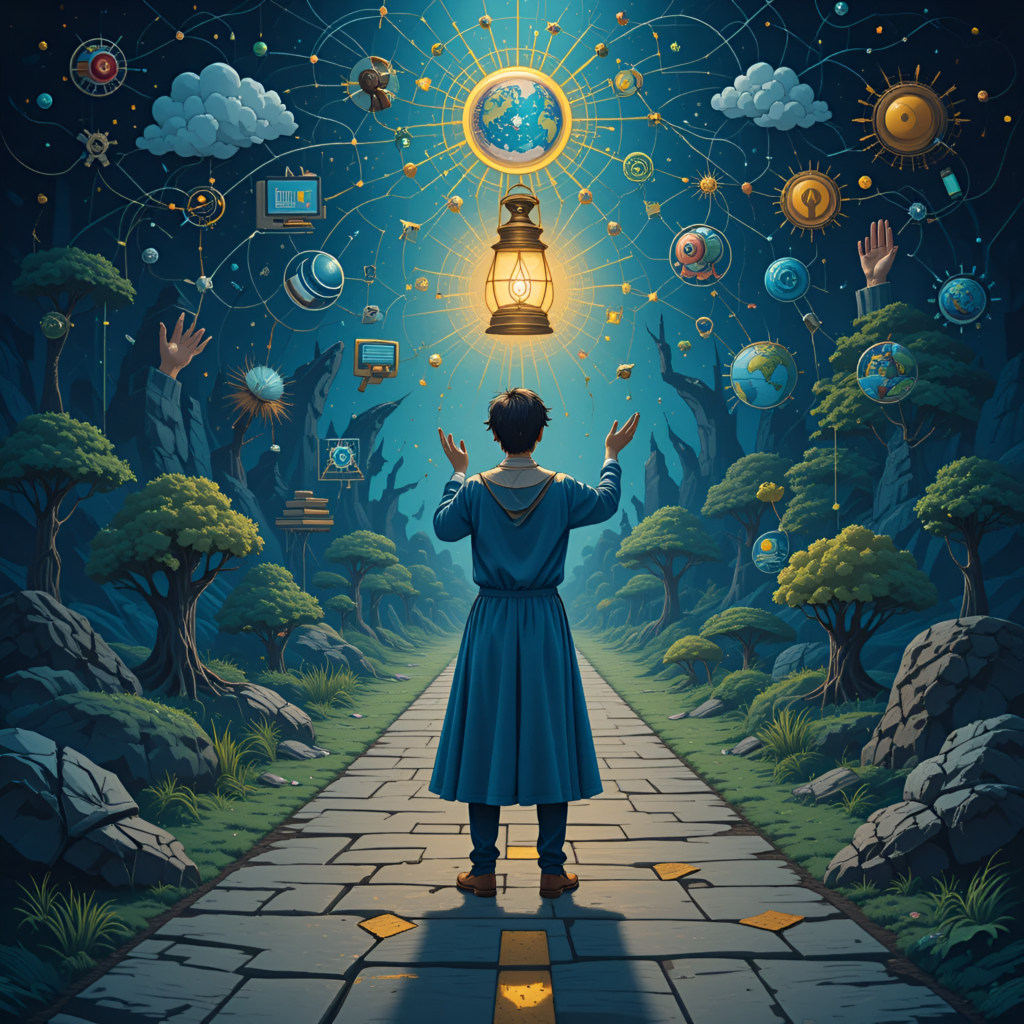
Ethics as Critical Inquiry
Ethical flashlight: exploring paths to the future
Ethics as critical inquiry implies not only rational analysis, but also affective responsibility and a transformative vision of the present and future. This image depicts a human figure holding a lantern, illuminating a path with technological forks that symbolize possible futures. On one side is a dark future, marked by pollution, surveillance and inequality; on the other, a hopeful future with regenerated nature, collaboration and sustainable technologies. The lantern symbolizes the ethics that reveal dilemmas and consequences, allowing for responsible choices. Around it, symbols of care and thinking tools reinforce the importance of projecting technologies oriented towards the common good, sustainability and hope, underlining the need for active ethics to guide our decisions.
A description of the creative process:
The image was created using the AI image generation tool PicLumen, focusing on a symbolic and philosophical composition. A central figure, which could be a teacher, young person or scientist, was designed to represent the ethical conscience that guides technological decision making. The lantern projects light on a path divided in two, representing possible futures with contrasting tones and elements: one somber and the other hopeful. Around the figure, visual icons such as hands, trees, connected people, books and circuits were incorporated, symbolizing care, reflection and responsibility.
The prompt was crafted to balance symbolism with a hopeful, futuristic style, using contrasts of light and color to highlight the duality of ethical choices in technology. Variations of the prompt were tested to adjust the level of detail and emphasize the reflective and optimistic atmosphere.
Prompt used in PicLumen:
“Symbolic digital art, a human figure (teacher, young person, or scientist) holding a lantern that illuminates a technological path with bifurcations. On one side, a dark future with pollution, mass surveillance, inequality; on the other, a hopeful future with regenerated nature, human collaboration, and sustainable technologies. Around the figure, floating symbols of care (hands, trees, connected people) and thinking tools (books, gears, circuits).”
This illustration seeks to encourage debate on technological ethics and the importance of imagining responsible and transformative futures in educational contexts.

Co-design
Hands United in Designing the Future
This illustration depicts technology co-design as a collective and inclusive process, where people of different ages, cultures and roles actively collaborate to create technologies that respond to their real needs and specific contexts. The scene shows a diverse circle – peasants, engineers, designers, youth and elders – prototyping a technological tool at a common table. All around, varied landscapes such as jungle, city, mountain and sea symbolize the importance of contextualization, reminding us that technology is not universal, but must adapt to cultural and environmental diversity. Luminous lines connecting hands, objects and environment illustrate technological mediation, showing how these tools transform and mediate our relationships with the world and with each other. The image highlights dialogue, respect and collaboration as the basis for responsible and socially just technological development.
A description of the creative process:
For this image, PicLumen, an AI digital art generation tool, was used to create a vibrant and symbolic composition that reflects collaboration, diversity and connection between people and environments. The visual focus is a diverse human circle working on a technological prototype, expressing the practice of co-design. The integration of multiple landscapes around it represents contextualization, while luminous lines connect key elements to symbolize technological mediation.
The prompt was carefully designed to emphasize warm colors, expressions of respectful dialogue and an atmosphere of working together, striking a balance between realism and symbolism. Adjustments were made to highlight cultural diversity and the positive interaction between social actors and nature. This image aims to inspire reflections on participatory and ethical methodologies in technological creation, promoting inclusion and care for the environment.
Prompt used in PicLumen:
“Vibrant digital art of diverse people (farmers, engineers, designers, youth, elders) sitting in a circle around a table prototyping technology (app, agricultural tool, educational device). Surrounding landscapes include jungle, city, mountain, and sea, symbolizing contextualization. Glowing lines connect hands, objects, and environment, representing technology mediating relationships.”
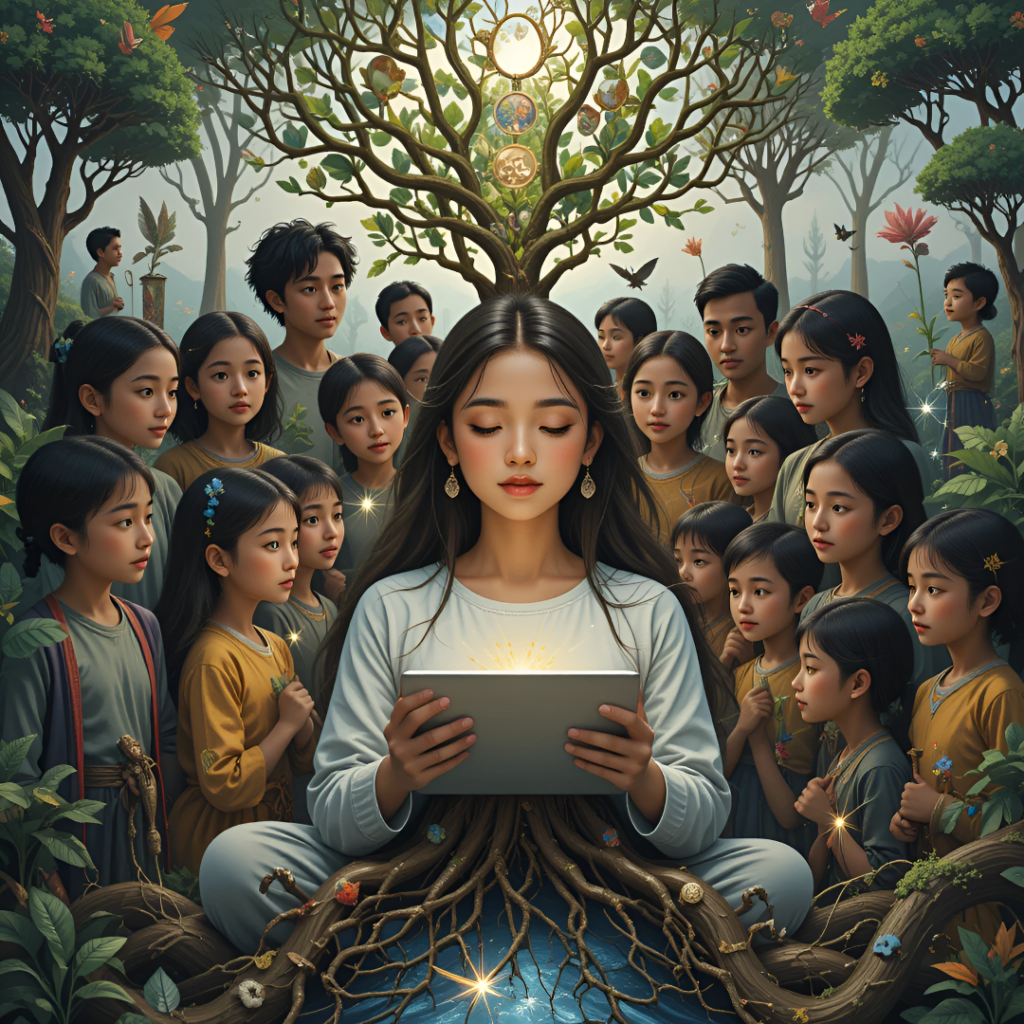
Ethics as care
Life-Sustaining Connections
This image represents ethics as care, a perspective that goes beyond abstract reasoning to emphasize sensitive, relational attention committed to the well-being of people and the planet. The central figure, designer of a technology integrated with natural elements, symbolizes connection and co-responsibility with the community and the environment. All around, diverse people – children, the elderly, people with disabilities – together with natural elements such as trees and animals, illustrate the possible harmony between innovation and life. The roots emerging from their hands symbolize the interconnectedness and ethical care that should guide technological development. The image seeks to make visible the empathy, justice and collective responsibility needed to create technologies that protect the vulnerable and sustain just relationships with nature.
A description of the creative process:
The image was created using the AI digital art generation tool PicLumen. The visual approach sought to convey a warm and poetic atmosphere, with soft natural tones that evoke serenity and connection. The composition places a central, attentive and sensitive person designing an organically integrated technology, surrounded by a diverse community and elements of the natural environment that reinforce the message of care.
To represent ethics as care, symbols such as roots connecting hands and earth were integrated, as well as flashes of soft light on faces to express empathy and stewardship. The prompt was designed to emphasize the relationship between technology, community and nature, with a warm and human digital style. Adjustments were made to balance symbolism and emotional expressiveness, achieving a visual impact that invites reflection on ethics committed to life and the planet.
Prompt used in PicLumen:
“Warm and poetic digital art of a person designing technology integrated with organic elements, surrounded by a diverse community (children, elders, people with disabilities) and natural environment (trees, animals, rivers). The person’s hands extend roots connecting to others and the earth, symbolizing ethical care. Soft natural tones, gentle light glows on faces expressing empathy and responsibility. Emphasis on harmony between innovation, people, and nature.”
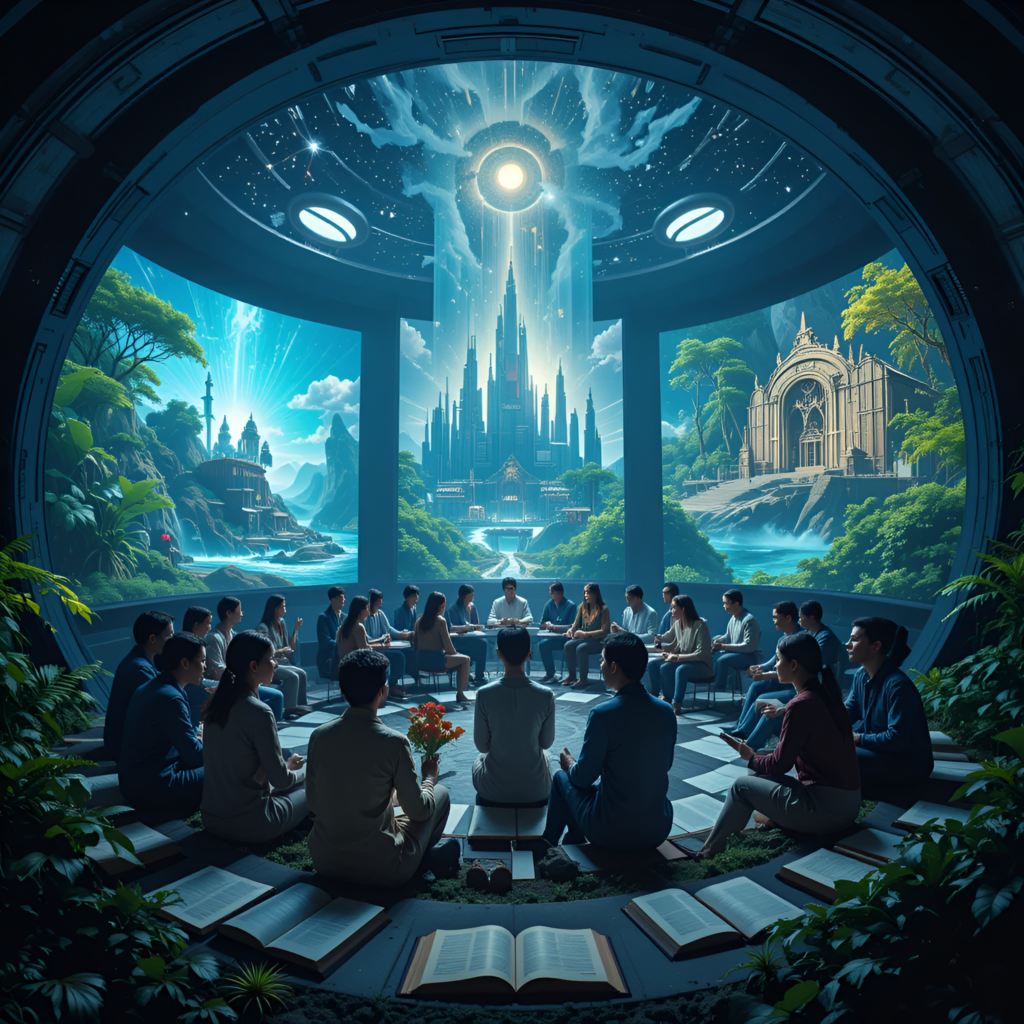
Future Imagination
Ethical Imaginaries for Possible Futures
This illustration represents the capacity of technological ethics to imagine diverse and sustainable futures, beyond technical inevitability. A diverse group of people – scientists, artists, youth, elders and indigenous communities – gather in a creative circle, projecting with holographic light different desirable scenarios: ecological cities integrated with nature, fair global knowledge networks and technologies that repair the environment. The image symbolizes ethical imagination as a tool for questioning the present and designing alternative paths towards a more just, ecological and communitarian coexistence. The starry sky with constellations that form symbols of justice and sustainability invites us to think of an open and hopeful future, where technology accompanies the care of the planet and people.
A description of the creative process:
For this image, I used the AI image generation tool PicLumen, orienting the composition towards a symbolic and dreamlike scene that highlights collaboration and diversity. The focus was on depicting a circle of heterogeneous people projecting possible futures with holograms of glowing light, expressing creativity and hope. I incorporated elements such as blueprints, seeds, books and circuits to show the connection between traditional and technological knowledge. The starry background was designed to suggest imagination and the infinite potential of ethics applied to technology.
The prompt in English was:
“Dreamlike digital art. A diverse group of people (scientists, artists, youth, elders, indigenous communities) sitting in a creative circle projecting holographic light showing three futuristic paths: an ecological city integrated with nature, a fair global knowledge network, and reparative technology for the environment. Starry sky with constellations symbolizing justice, sustainability, and community.”
I made adjustments to detail and luminosity to balance symbolism and visual clarity. This image seeks to inspire dialogues about how ethics can shape more humane and sustainable technological futures.
Federica Caciolli
Graduated, University of Firenze (Italy)
Futures in Tension
Description
“Futures in Tension” is a sequence of ten illustrated cards that interrogate the promises and perils of educational technology. Each piece is conceived as a miniature thought-experiment: a richly symbolic tableau that exposes the ecological, social and political forces hidden inside everyday devices and platforms. The series was built through an iterative, hybrid workflow. I drafted high-level concepts, then generated base imagery in generative-AI tools best suited to the style—DALL·E 3 for painterly scenes, Midjourney v6 for collage-like compositions, Stable Diffusion XL for charcoal textures. Depth maps or upscaled PNGs were exported into Blender or Photoshop, where I modelled bespoke elements (fibre-optic cables, LEGO-style bricks), painted over details, applied gradient-map colour grading (project teal–magenta) and added analogue flourishes—chalk textures, water-colour bleeds, subtle grain. Inspirations range from Moebius and Studio Ghibli backgrounds to Hannah Höch collages and classic cinema chiaroscuro. Together, the cards invite educators, students and policymakers to reflect on power, equity and care before chasing the next upgrade.
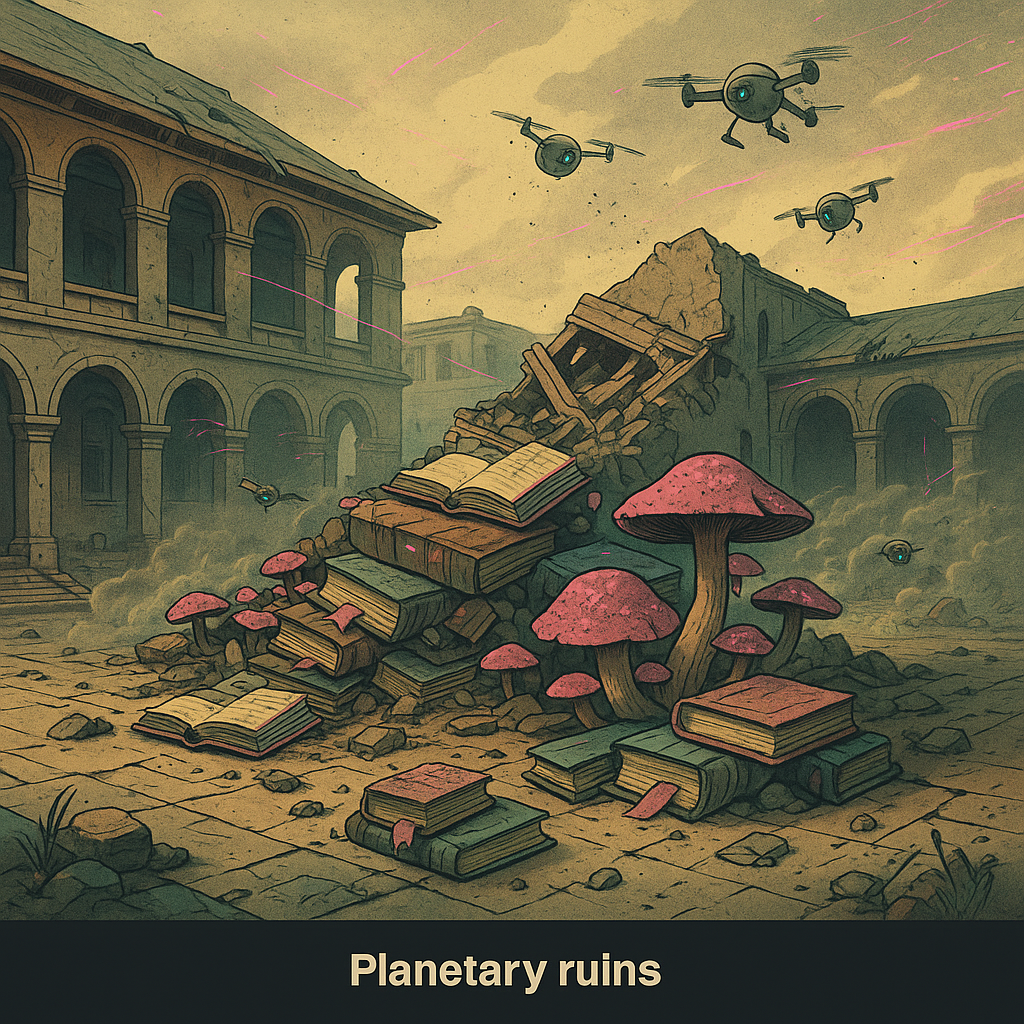
Planetary Ruins
The concept of “planetary ruins” shines a light on the material footprint that every piece of educational technology leaves behind. From lithium extraction and cobalt mines to the mountains of discarded tablets and the power-hungry data centres that fuel generative AI, our tools of learning are embedded in a destructive supply chain that rarely features in syllabi or marketing brochures. By shrinking this global story into the familiar setting of a campus courtyard—half collapsed under its own ecological weight—the card reminds viewers that every upgrade is already tethered to damage elsewhere. The toxic mushrooms echo the uncanny growth of e-waste, and the drones cleaning micro-plastics ask whether “smart” solutions can keep pace with self-inflicted harm. In short, the card poses an uncomfortable question: not whether technology can enrich learning, but whether we can learn to live with its ecological debt.
Prompt:
Ultra-detailed isometric illustration of a half-collapsed university courtyard where textbooks sprout like toxic mushrooms; drones collect micro-plastics swirling in the air; palette of desaturated earth tones with flashes of neon pink glitch; style of Moebius meets Studio Ghibli, 4K, posterized shading.
Creative process:
I started in DALL·E 3, feeding the prompt shown above and requesting four variations at 4 K resolution. I chose the version whose sight-line drew the eye from foreground debris to distant collapsed arches, leaving breathing room for possible future captions. Once exported as PNG, I opened the file in Photoshop and replaced the sky with a royalty-free smog gradient, Soft Light 50 % opacity, to avoid crushing mids.
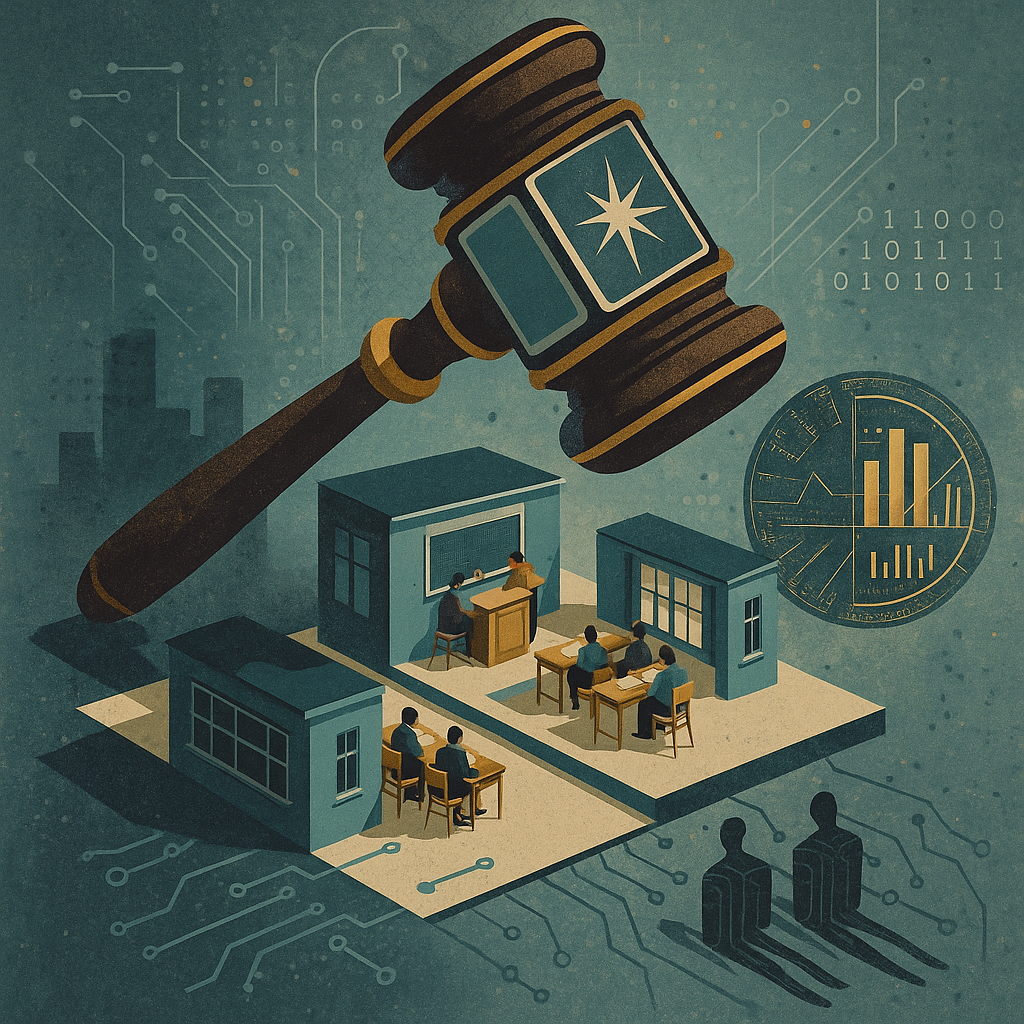
Political power
Educational technology is never neutral: licenses, data pipelines and algorithmic rules embed political decisions that shape what, how and for whom learning happens. The hovering gavel made of smartphone screens symbolises the regulatory and corporate power wrapped inside everyday devices; miniature classrooms beneath it visualise how policy choices filter down to lesson plans and grade books. Circuit diagram shadows hint at hidden logic that decides visibility or exclusion, while the blue grey/anthracite palette conjures legal steeliness. The gold accents, meanwhile, recall the profit streams that often determine which “innovations” reach classrooms first. Together these elements bring power structures onto the stage, urging educators and students to notice the room above their heads—and to push for transparency, contestability and common good governance. The card does not reject platforms outright; it simply makes space to demand democratic accountability in EdTech ecosystems.
Prompt:
Surreal collage: a giant gavel made of smartphone screens hovers over miniature classrooms; students’ shadows are circuit diagrams; muted blue-grey palette with gold accents; style reminiscent of Hannah Höch digital cut-outs, 8K resolution.
Creative process:
I began in Midjourney v6 with the prompt above plus the switch “–style raw” to avoid heavy stylisation. After eight iterations I selected the composition in which the gavel occupies the upper third, creating a natural power imbalance in the frame. Midjourney’s upscaler produced an 8 K PNG, which I imported into Illustrator and ran through Image Trace at 12 colours to vectorise the gavel for further editing.
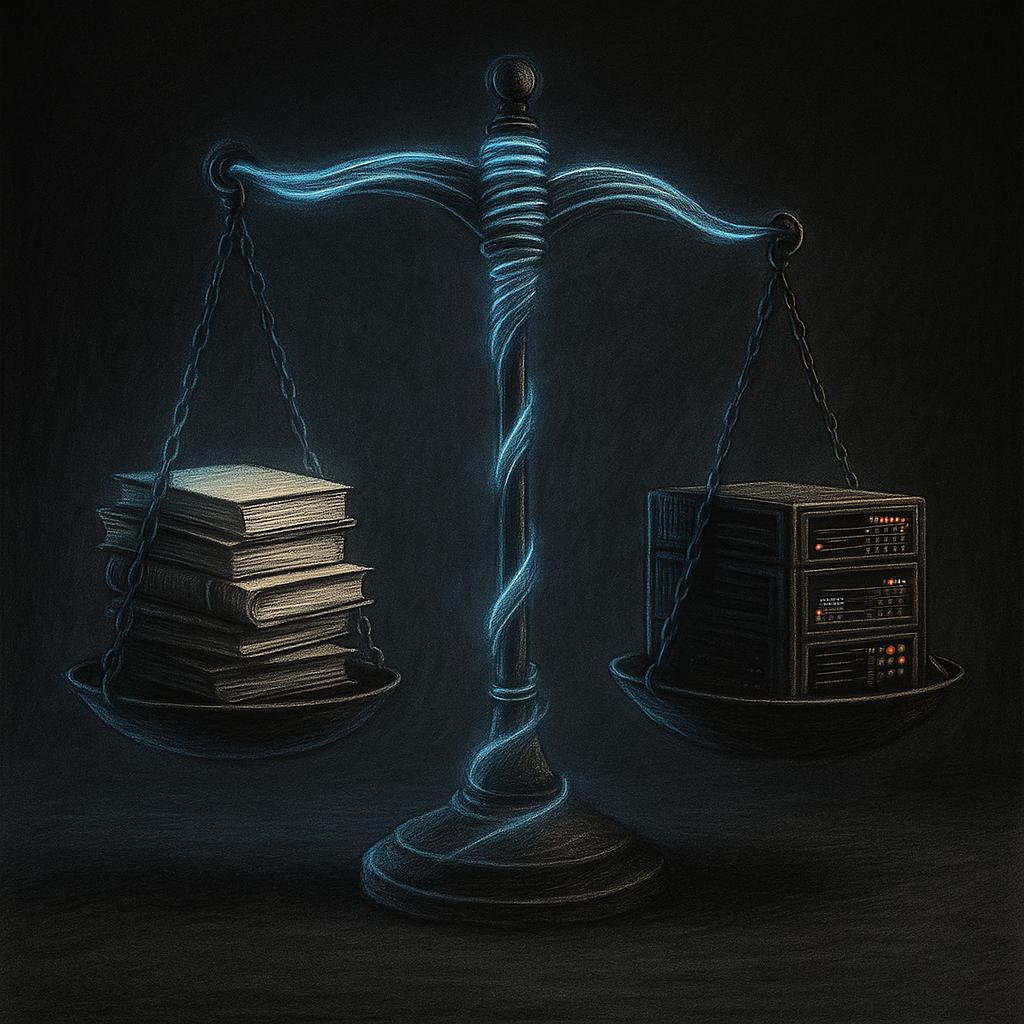
Global Inequality
Global access to educational technology is profoundly uneven: while a handful of wealthy campuses spin up GPU clusters for real-time AI tutors, learners in many regions still share a single outdated computer or rely on photocopied notes. Building the concept into a fragile balance scale forged from glowing fibre-optic cables makes inequality tangible and precarious—if the heavy server pan keeps loading, the cable will snap and both sides will crash. The dim chiaroscuro lighting is a reminder that the situation often stays in the dark until policy failures finally break the system. The card invites educators to weigh each new hardware rollout against the opportunity cost elsewhere and to think of international partners not as beneficiaries but as co-owners of digital futures.
Prompt:
Conceptual balance scale made of glowing fibre-optic cables: one pan overloaded with humming server racks, the other with empty paper notebooks; dim background, chiaroscuro lighting; style of cinematic photography meets charcoal sketch, 6K.
Creative process:
I created the first draft in Stable Diffusion XL with the prompt above, requesting a 4 K output and setting CFG 8 to keep details tight. After identifying a seed with balanced composition, I exported the depth map and moved into Blender. There I constructed curves that matched the cable path and converted them into mesh tubes textured with an emission shader (hex #00FFEE at 20 % strength) plus a subtle noise bump to mimic braided fibres.
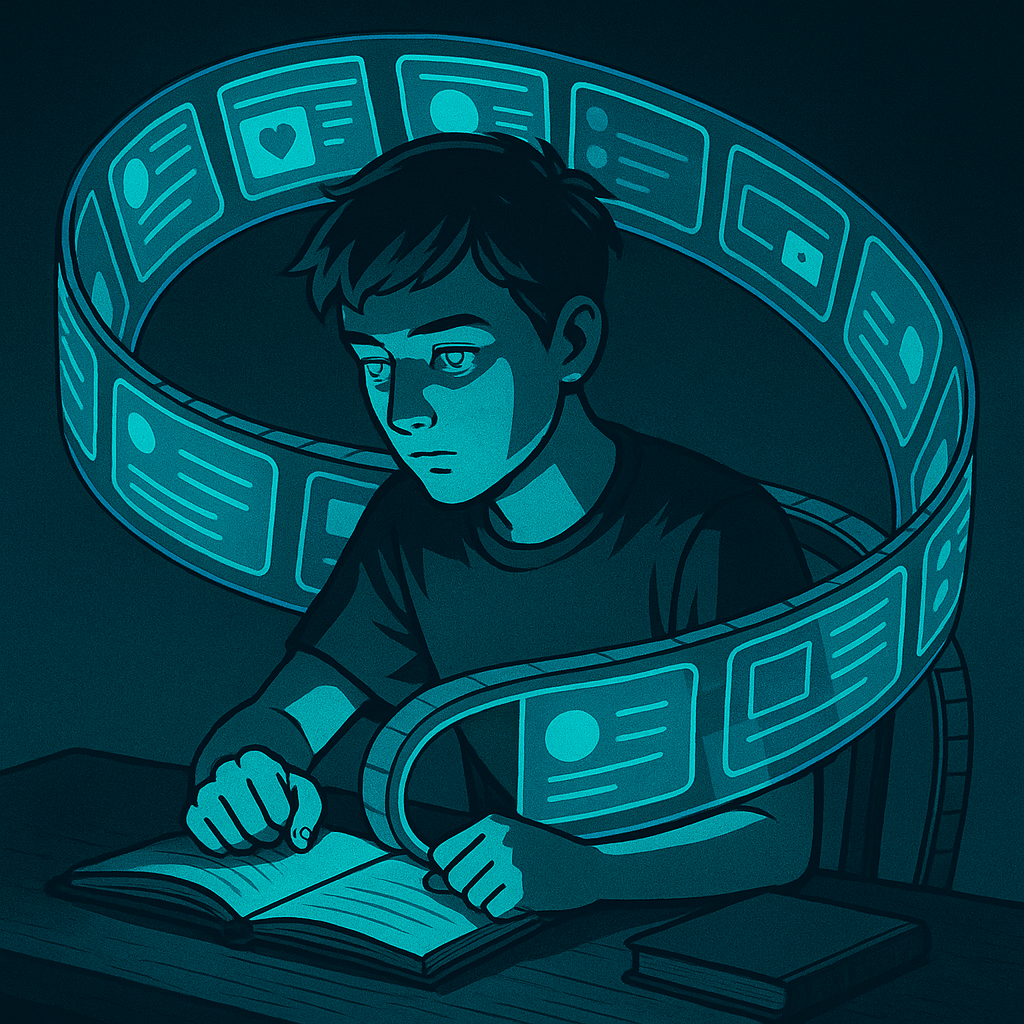
Addiction/Dependency
Compulsive design patterns—endless scroll, autoplay lessons, badge streaks—can transform tools intended for learning into attention traps. The card stages a teenage student on an infinite conveyor belt made of social media windows that circle back on themselves, turning curiosity into fatigue. Translucent panes signal how the mechanics of seduction are usually invisible, yet their glow is reflected in the student’s eyes, suggesting internalised rhythms of notification and reward. The cyber noir palette evokes late night binge usage, while the looping belt references industrial time and motion studies, implying that human focus is being fed to machines. By freezing the loop in a still frame, the card asks whether we notice when learning moments become mere engagement metrics, and challenges teachers to design interventions that break, rather than reinforce, dependency cycles.
Prompt:
Infinite conveyor belt feed made of translucent social-media windows loops around a teenage student seated at a desk; student’s eyes reflect endless scrolling; cyber-noir palette with saturated cyan highlights; 3D render mixed with cel-shading, 4K.
Creative process:
I built a low-poly conveyor belt in Blender, array-modelling half-pipes arranged in a Möbius loop so the feed has no exit. Screenshots of popular social apps were placed onto translucent planes using UV projection with Emission shaders to simulate screen glow. The student character was generated separately in DALL·E 3 (“teen sitting at desk, neon cyan rim light, contemplative expression”).
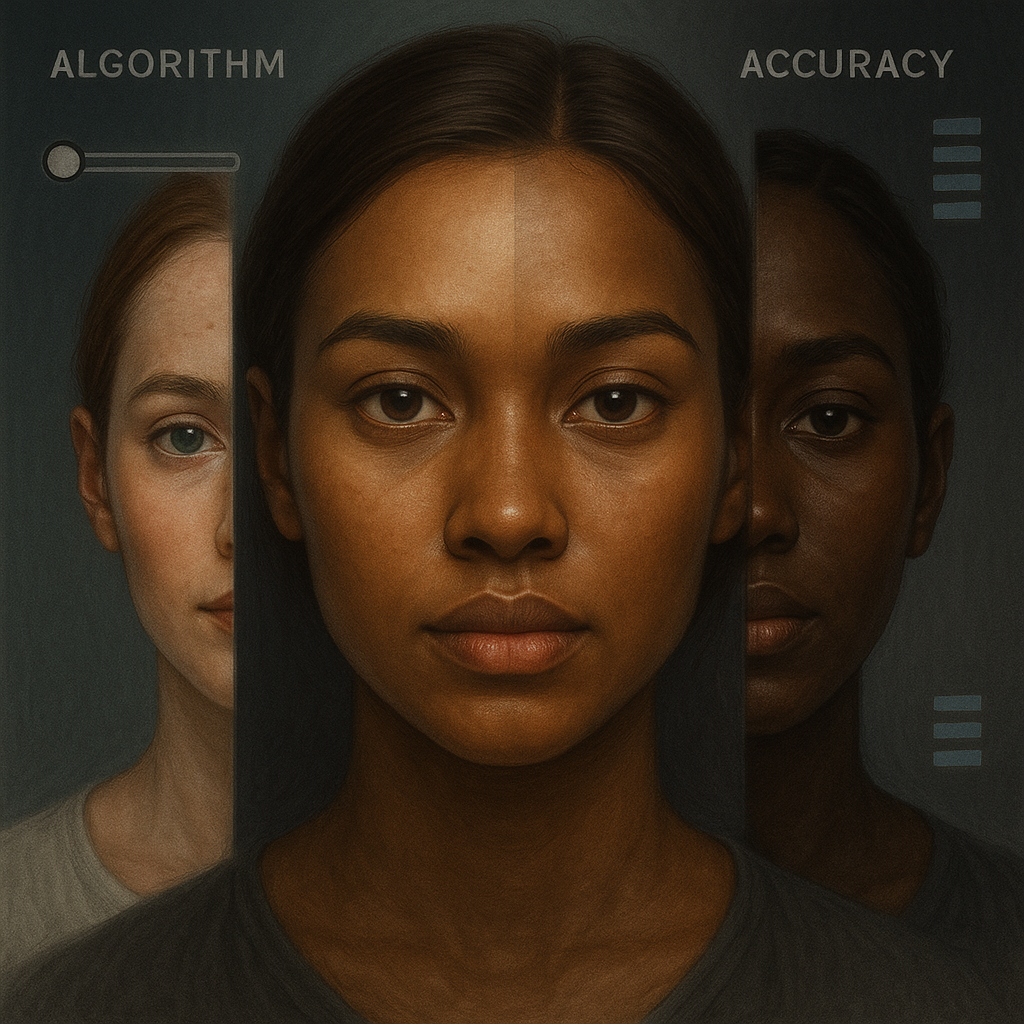
Bias/Discrimination
Algorithms can amplify social prejudice when the data that trains them or the objectives that steer them are skewed. In this portrait sequence, the same face morphs through multiple skin tones while an on-screen slider claims to optimise “accuracy,” exposing how subjective categories are masked by technical language. Accuracy bars that jump taller or shorter as tones shift remind viewers that statistical performance often serves as a proxy for normative judgments about who counts, and who can safely remain unseen. By highlighting a single mutable face, the card makes discrimination personal, not abstract, and hints at intersectional factors—age, gender, accent—that would compound the injustice. The viewer is invited to question default settings: if a single face can be reconfigured to meet shifting metrics, perhaps the metrics—not the person—demand scrutiny.
Prompt:
Portrait sequence: same face morphs through multiple skin tones as an on-screen algorithm slider is dragged; background UI shows accuracy bars shifting; hyper-realistic digital painting, smooth transitions, 8K.
Creative process:
I generated 3 high-resolution portraits in DALL·E 3—same facial geometry, 3 distinct skin tones—by fixing the seed and altering only the descriptor of complexion. I batch-exported the images as TIFFs and imported them into After Effects.
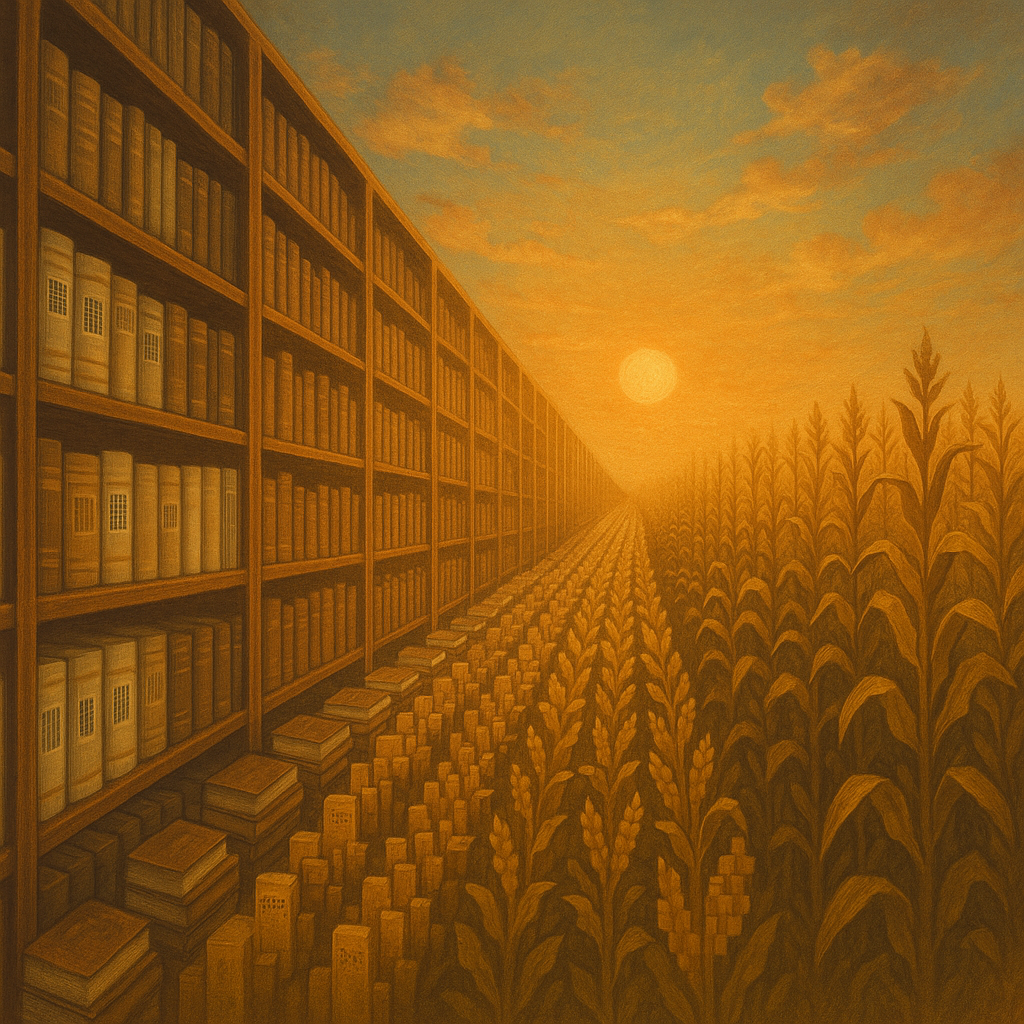
Cultural Impoverishment
When recommender systems and content marketplaces reward engagement above all, classrooms risk converging on the same handful of lowest friction resources, gradually replacing the messy diversity of cultures and languages with a monocrop of homogenised material. In the card, a grand library morphs into endless rows of pixel corn—identical books tagged only by blank QR codes—illustrating how optimisation can empty learning of context and texture. The warm sunset hints at natural beauty, yet the desaturated palette and rigid grid signal that colour and nuance have been algorithmically drained. A thin line of living greenery remains on the horizon, a final warning that curricular ecosystems can still be saved if educators choose polyculture over convenience. The card calls readers to cultivate curricular biodiversity before the shelves finish turning into sterile rows.
Prompt:
Vast library morphs into a monoculture field of pixel corn, shelves replaced by endless rows of identical books with blank QR codes; warm sunset but desaturated tones; painterly realism inspired by Hayao Miyazaki backgrounds, 5K.
Creative process:
The base image was produced in DALL·E 3 with the prompt above at 4 K resolution, explicitly instructing a Hayao-Miyazaki-inspired painterly background. To align with series colours I created a teal-magenta Gradient Map set to Soft Light 25 %, and selectively desaturated reds. A mild Oil Paint filter added subtle brush strokes, connecting digital and analogue aesthetics.

Ethics as Critical Inquiry
Ethics, at its core, is a disciplined habit of questioning—one that spirals inward as knowledge grows rather than resolving into a final checklist. This card projects a magnifying glass onto a chalkboard filled with equations; inside the bright circle, a fractal of question marks appears, each containing smaller lenses in a recursion without end. The limited colour scheme—teal strokes on anthracite—references the project palette while leaving space for chalk dust textures that evoke classroom practice. By letting punctuation override formulae, the composition argues that curiosity should interrogate even what feels settled or certain. The image insists that ethical reflection must be woven into disciplinary work, not appended as a disclaimer at the end of a syllabus; otherwise, the glass magnifies nothing but its own surface.
Prompt:
Magnifying glass projects fractal question marks onto a chalkboard filled with complex equations; each question mark recursively contains smaller lenses; limited palette, teal and off-white on anthracite background; vector-flat style with subtle drop shadows.
Creative process:
I drew the entire composition in Adobe Illustrator. Starting with a simple circle, I converted it into a magnifying-glass shape using the Warp > Bulge tool, then duplicated the object maaaany times. With Transform Each I reduced scale by 70 % and rotated 15° per iteration, enabling a logarithmic spiral that suggests infinite depth. The question-mark glyph was hand-lettered using a variable-width brush, expanded, outlined, and placed inside every alternate lens to avoid clutter.
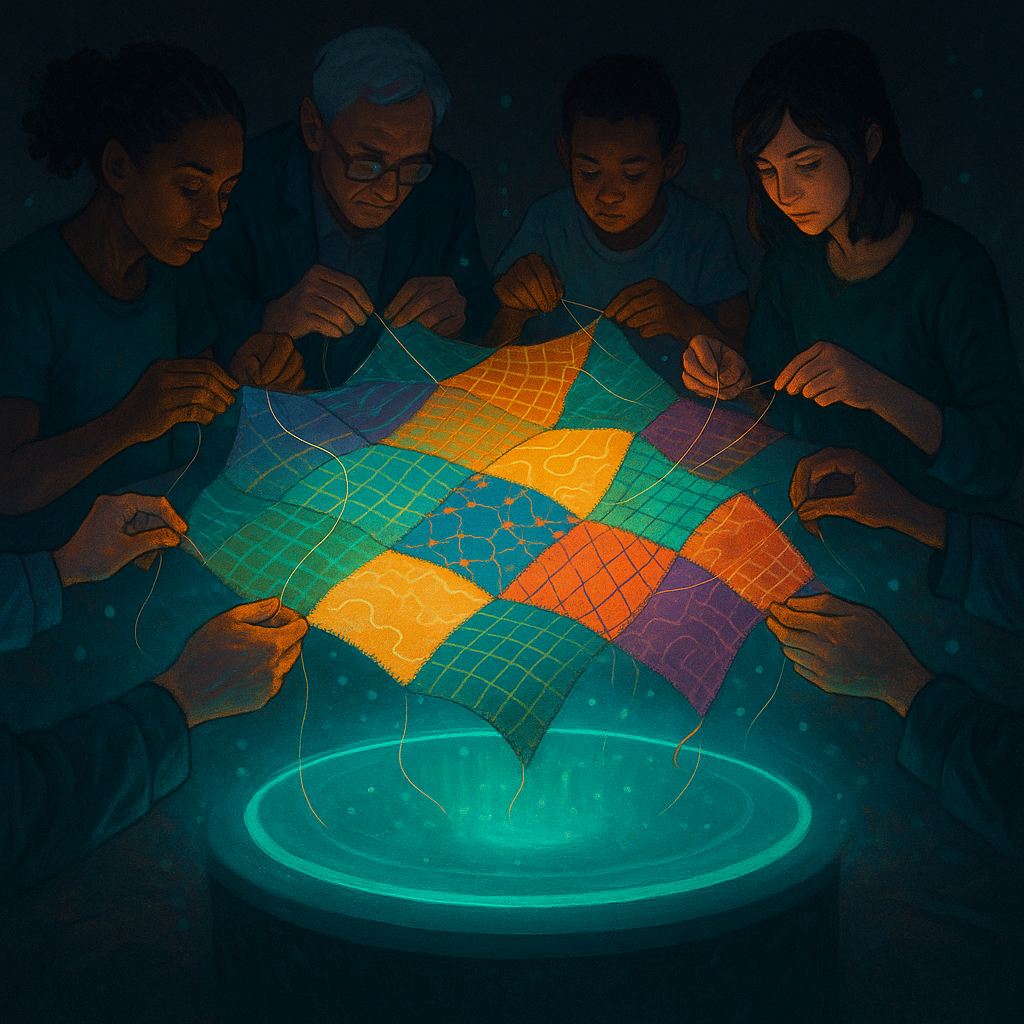
Mediation & Co-design
Responsible technology does not arrive pre-assembled; it is stitched together through dialogue among the people who will teach, learn and maintain it. In this scene, educators and students stand around a holographic round table, piecing colourful data-fabrics into a single quilt that floats in mid-air. The soft particles swirling in the dark workshop suggest both creativity and the messy uncertainty of co-design. Each patch carries its own weave, symbolising disciplinary diversity: sociology patterns interlock with computer science fibres, art textures back mathematics grids. By giving the fabric its own glow, the card stresses that context and meaning emerge from collaboration, not from black-box tools handed down by vendors. Only when stakeholders sew technology into local narratives does it hold together.
Prompt:
Round holographic table in a dark workshop where diverse educators and students stitch colourful data-fabric pieces into a shared quilt; dynamic lighting, soft particles floating; photorealistic 3D with painterly overpaint, 6K.
Creative process:
I blocked the environment placing eight human figures in half-lit poses around a circular table set as an emissive object. I generated procedural cloth patches using the Cloth Surface modifier and applied vertex colour gradients sampled from project teal and magenta. A volumetric spotlight generated floating dust which I cached to reduce render noise.
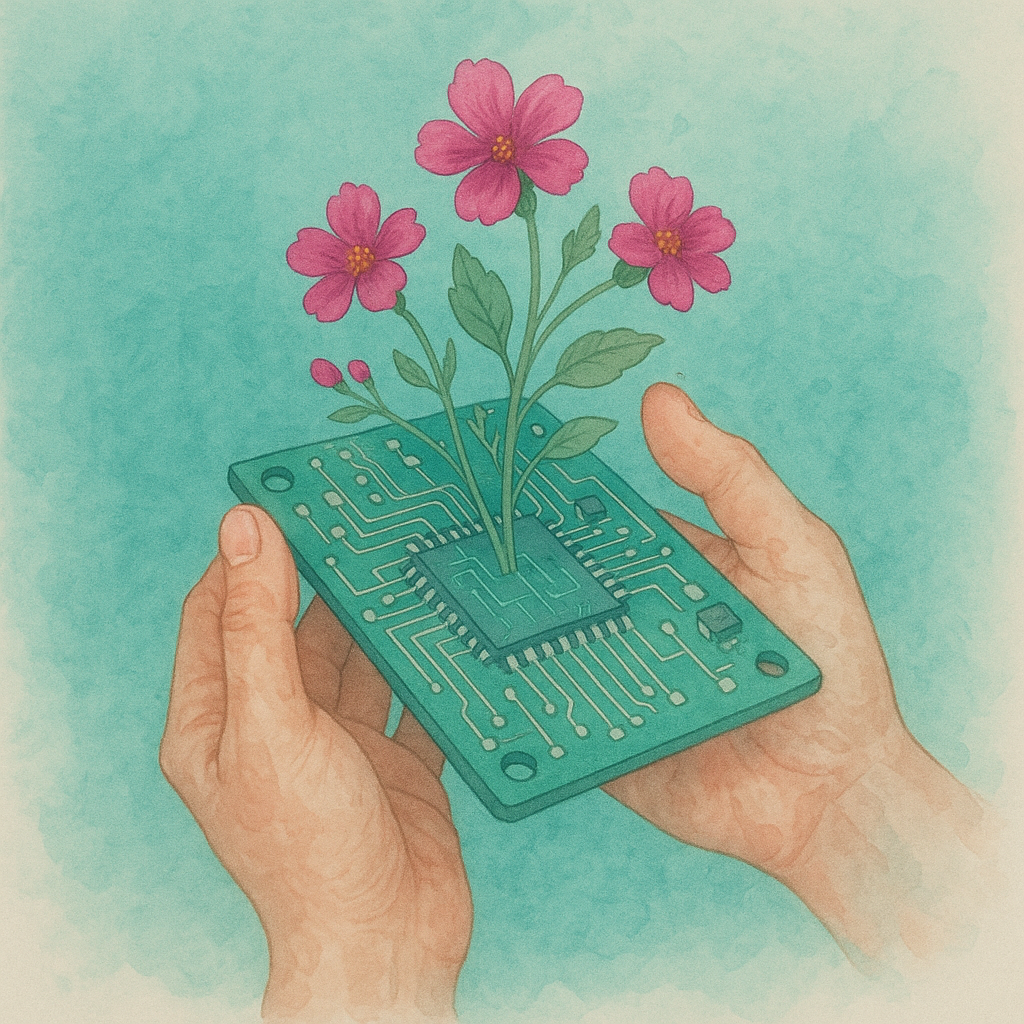
Ethics as care
Ethics as care foregrounds relationships and vulnerability—values often ignored by data dashboards. Two gentle hands cradle a fragile circuit board sprouting flowers, showing that technical infrastructure can be tended like a garden rather than mined for output. Watercolour textures blur the line between nature and circuitry, suggesting that well being arises when human support and digital systems are cultivated together. The pastel teal background keeps the mood calm, while magenta blooms signal vitality. By spotlighting care work—maintenance, listening, patient iteration—the card challenges the heroic myth of disruption and reminds viewers that sustainable innovation depends on the people who keep technology alive after launch. Empathy and ongoing stewardship are as critical as breakthrough ideas within educational technology.
Prompt:
Close-up of two hands gently cradling a fragile circuit board sprouting delicate flowers; watercolor digital painting with soft edges and minimal line art; pastel teal background with magenta bloom accents; 4K.
Creative process:
I painted the base composition in Procreate on a 4 K canvas using MaxPack Watercolor brushes. The hand outlines were traced from a CC0 reference photo, then softened with a wet-edge eraser. In Procreate I enabled Brush Bleed at 15 % to create organic pigment diffusion.
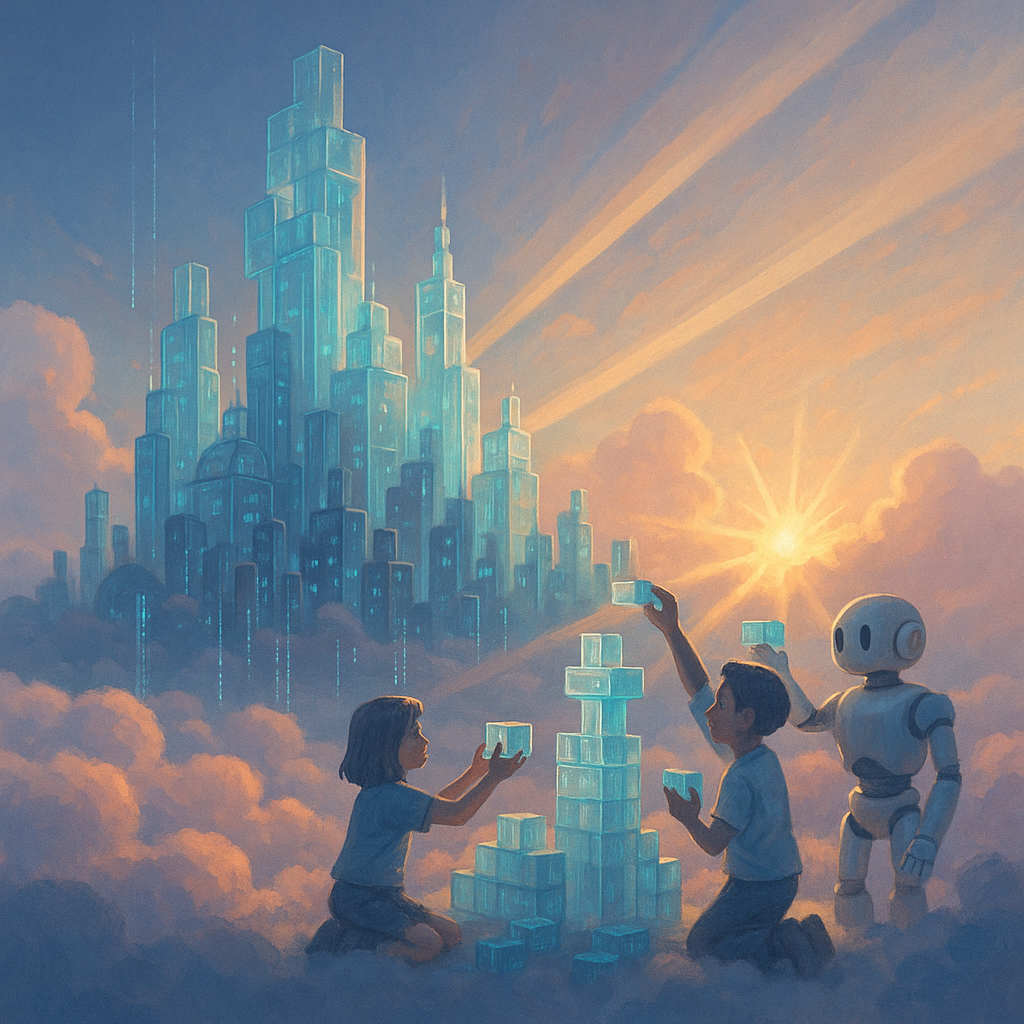
Future Imagination
The final card celebrates future imagination: the capacity to design learning environments we cannot yet fully describe. A translucent skyline built from LEGO-like blocks floats above clouds, assembled in real time by children and robots working side by side. The scene invites viewers to see technology not as destiny but as construction kit: modular, transparent, ready to be taken apart and rebuilt. Dawn light casts long rays, signalling that the work is only beginning, while faint data streams drifting upward hint at infrastructures engineered for accountability and care—in stark contrast to the opaque pipelines of today. By letting the pieces remain partially open-ended—some bricks hover waiting for connection—the image argues that ethical futures must remain revisable, welcoming new builders as contexts and values evolve. Hope is framed as a collaborative, continuous project.
Prompt:
Dream-like skyline floating above clouds, built from translucent LEGO-like blocks emitting faint data streams; children and robots collaboratively assemble new towers; bright dawn light with rays; semi-realistic matte painting, 8K.
Creative process:
I kit-bashed a set of translucent LEGO-style bricks in Blender using a Boolean workflow to hollow each block, then applied a Glass BSDF shader with dispersion set to 0.015 to catch spectral highlight. In Photoshop I performed matte painting: extending cloud banks with custom cloud brushes, painting god-rays via a white soft round brush plus Radial Blur (zoom 15 %).
Sergio Carvajal-Leoni
Ph.D. Student, Texas State University (USA); Erasmus+ Student, University of Padova (Italy)
Codifications of a Post-Digital Reality
Description
What is reality when we are unable to separate ourselves from the digital environment? Can mere words suffice to describe what that reality would be like? These art codifications adapt Freirean methodology to the era of AI content creation, where art-making has become democratized. As part of a new generation of adult educators, I explore themes of importance to my community using tools that generate robust, fast, and striking visual representations in ways never before possible. Each image was created using Midjourney 6.1, Sora, and Adobe Photoshop 2025, designed by a human artist in collaboration with a custom-trained GPT named Paulo Marshall McFrerean: the digital son of Marshall McLuhan and Paulo Freire. This GPT was fed seminal texts by both thinkers and shaped through reflective dialogue with the artist. The process involved iterative prompting, re-uploading, and reprompting, followed by Photoshop editing to achieve a uniform, square visual aesthetic reminiscent of Instagram. These are visual provocations – artifacts of thought that disturb, reveal, or imagine. They are ambiguous and resistant to simple interpretation. Ultimately, they are critical: each image invites (perhaps even pushes) the viewer to seek reality through a different lens, hoping the messages encoded within them will resonate and incite deep, transformative reflection. They are intended for both personal meditation and collective inquiry, especially when decodified among co-creators of knowledge.
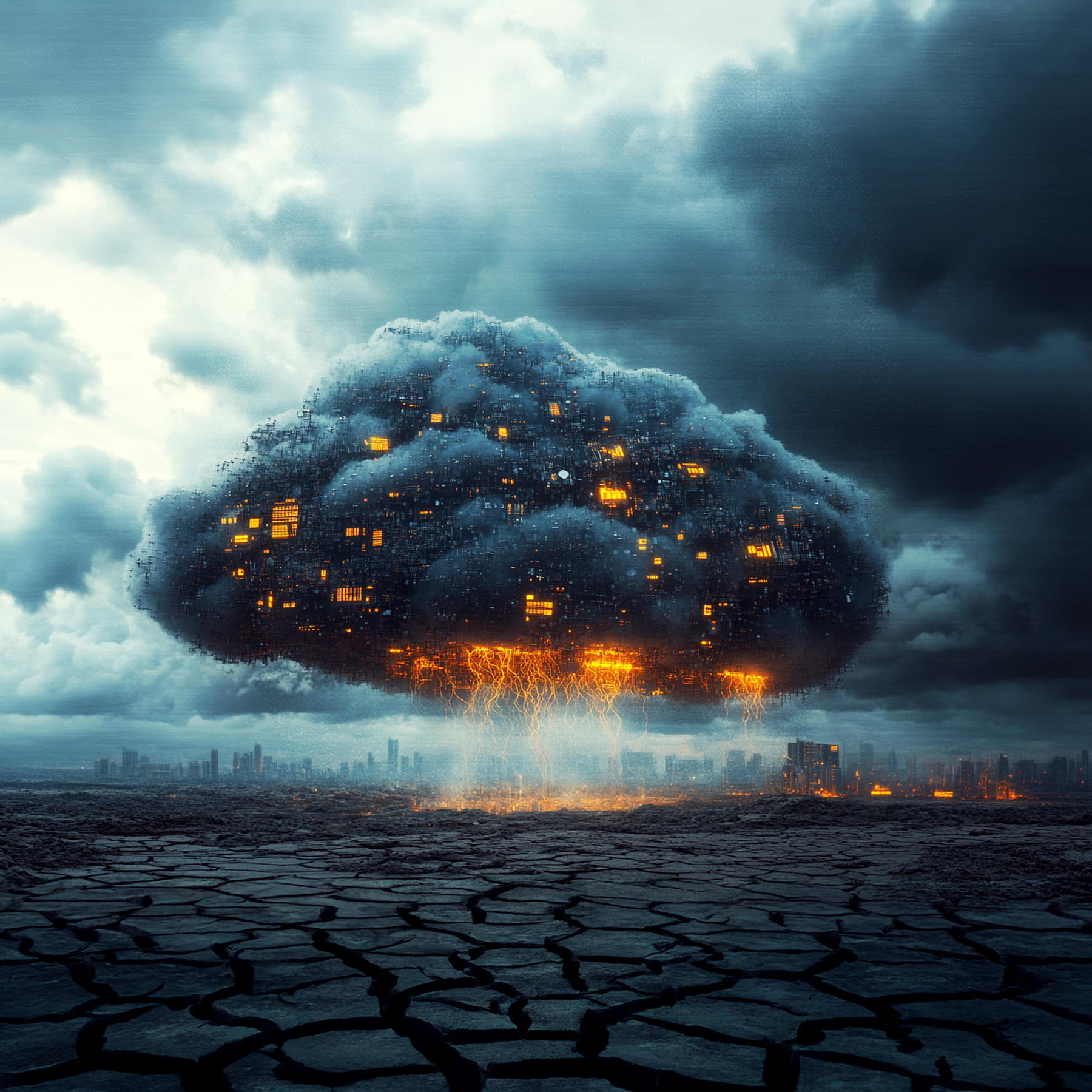
Planetary Ruins
The Cloud is Not Made Out of Clouds
This image depicts the overlooked yet pressing reality that those digital clouds we love are not really made out of organic materials. Instead, they’re made out of metal and plastic; they suck energy at an incredible rate. Most importantly, they thrive in environments where life does not exist.
This codification was done through multiple prompts and remixes, using Midjourney V6.1 and a custom-trained GPT as collaborator. The image was finished using Adobe Photoshop to expand key areas. A tracking VHS overlay was placed on top to provide texture and a feeling of analog vs. digital tension.
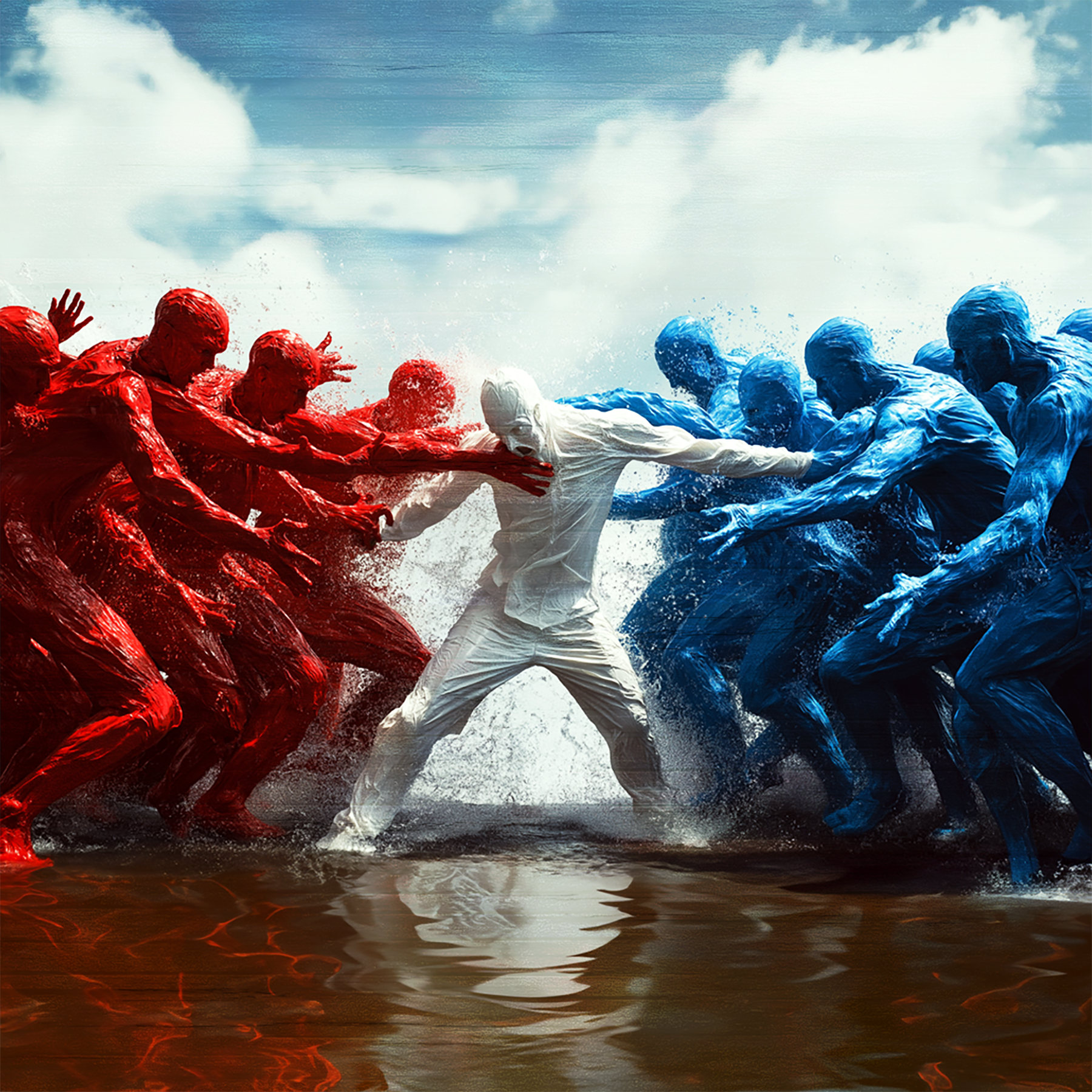
Political power
Education Should Be Political, Not Partisan
In the era of pervasive, fluid, and faceless algorithms, partisan politics rip our identities apart, pushing us to conform to a bewildering, one-size-fits-all style of engagement. This image shows the futile yet essential battle against these forces of oppression, where humans are used as the rope in a digital tug-of-war, their agency stripped in the name of tribal allegiance.
This codification was created through multiple prompts and remixes, using Midjourney V6.1 in collaboration with a custom-trained GPT. The final image was shaped in Adobe Photoshop, expanding key areas and layering in the murky, mineral-rich liquid below the figures to ground the metaphor in bodily terrain. A glitch overlay was applied to signal the mediation of the struggle: this war takes place in feeds, timelines, and algorithmic tunnels where the battleground is often invisible, yet always active.
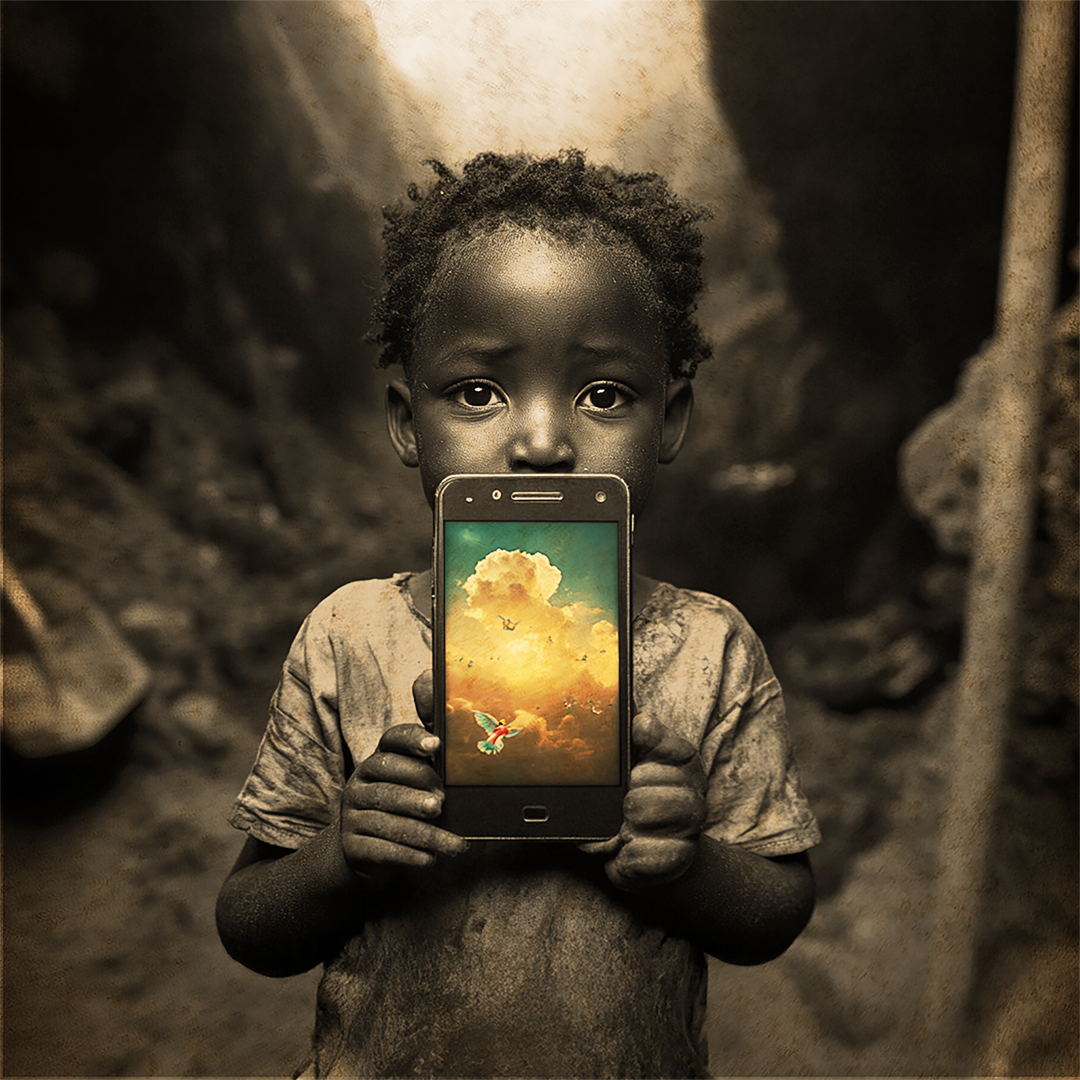
Global Inequality
How Convenient Is Your Personal Computer?
An African child, deep inside the mine where he is forced to work, holds in his hands a phone he will never be able to afford. The screen glows with scenes of freedom he will never experience. The old photo texture and black-and-white tone of the image suggest this reality has existed for quite some time. In the end, slavery hasn’t gone away; we just got used to it, and accept it as the price some unfortunate souls must pay for our convenience.
This codification was done through multiple prompts and remixes, using Midjourney V6.1 and a custom-trained GPT as collaborator. The image was finished in Adobe Photoshop, where areas were expanded, saturation levels adjusted, and old photo textures added. The content of the phone was left in color: jarring, seductive, and brutally out of place.
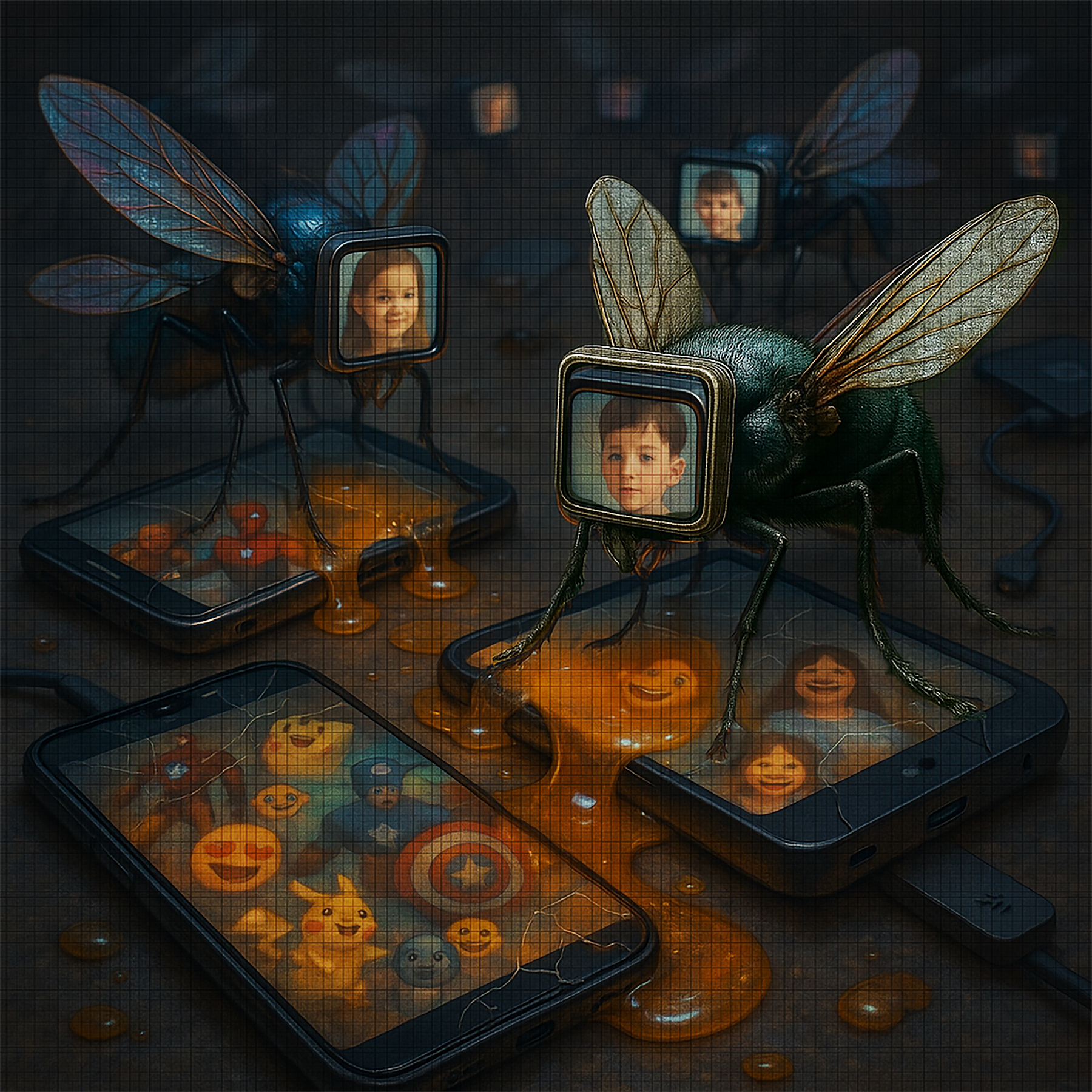
Addiction/Dependency
My Content is Quite Yummy, I Just Can’t Get Away
Behind an insect screen, a swarm of digital flies (each representing the fragmented identities of our children) rejoice in consuming the digital content prepared for them. Addiction and conditioning begin before language itself. Before we can formulate thoughts, we begin losing the sense of ourselves.
We see this happening and place thin, symbolic barriers between us and the problem (screens, filters, safety settings) hoping they’ll keep the truth away, so it won’t affect us emotionally.
This codification was created using Sora; the prompt was developed in collaboration with a custom-trained GPT. The image was iterated and remixed in Sora, then taken into Adobe Photoshop to integrate visual elements and layer in the insect screen texture. The flies, the children, the glow of their feast; it all asks: what have we made them hungry for?
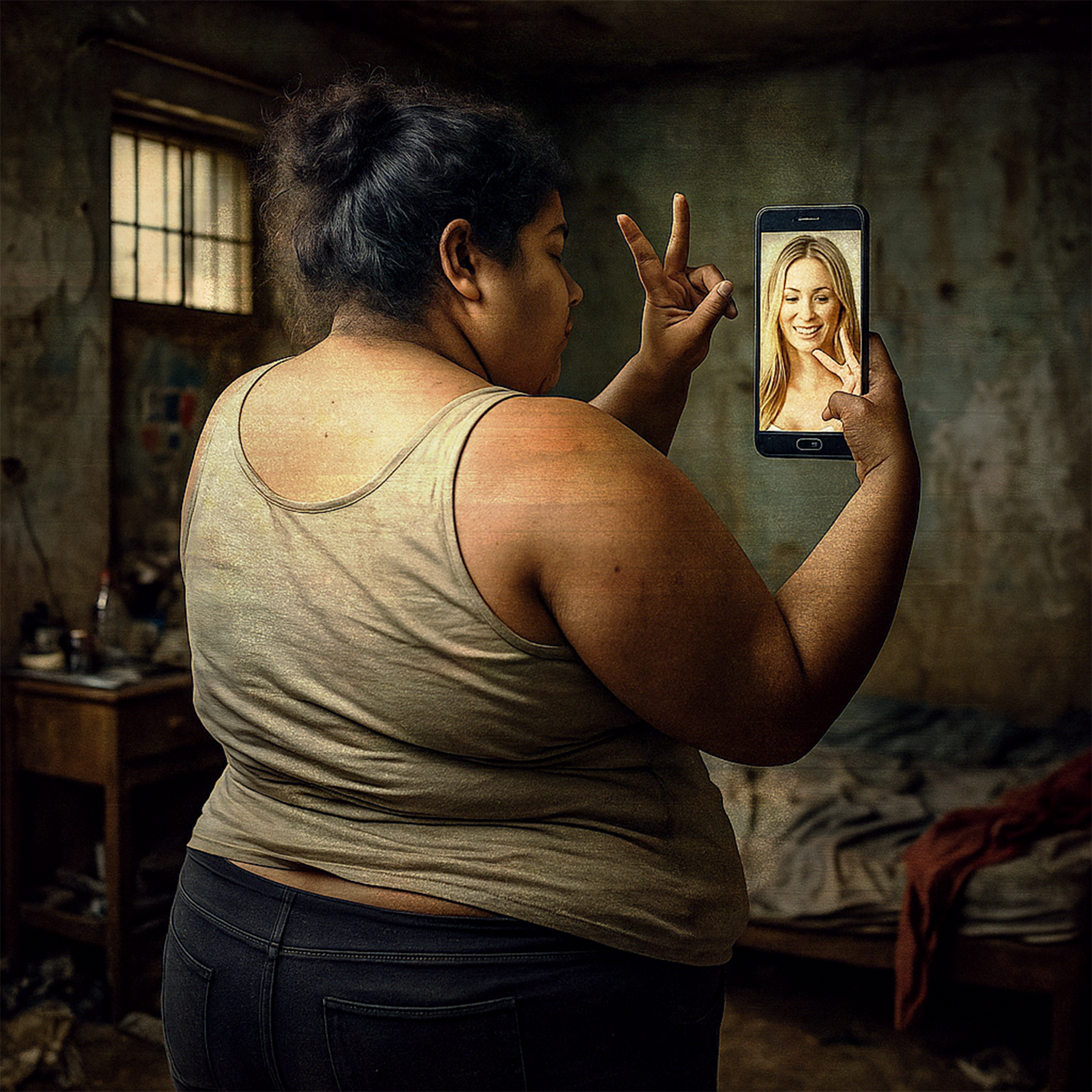
Bias/Discrimination
I Can Be However I Want to Be
A young woman watches herself in the digital mirror, distorting her beauty to fit the standards she has been conditioned to adore. Her wants and desires are not entirely hers, and yet, she controls the output. Her actual reality becomes superfluous, much less important than the one provided by the digital environment through the glowing, portable screen. This is the subtle cruelty of discrimination, embedded within the tools we use to shape ourselves.
This codification was created through conversational prompting with a custom-trained GPT, using ChatGPT. The image was remixed and finalized in Adobe Photoshop, where additional textures were layered in to evoke a grittier, timeless atmosphere. What emerges is personal and systemic: the fantasy of liberation masking a deeper form of confinement
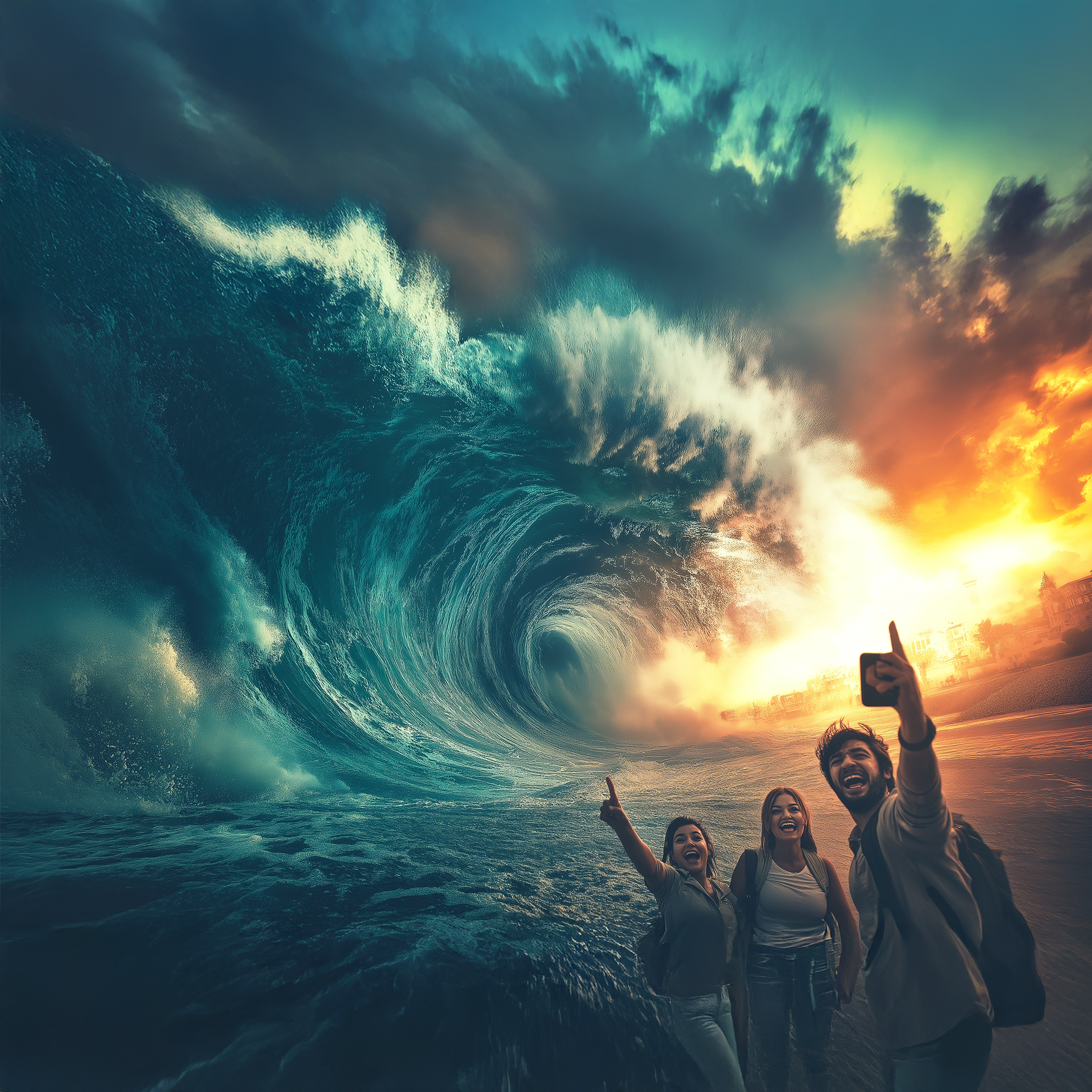
Cultural Impoverishment
Perceived Relevance Is All We Truly Need
True relevance is gone. It has been replaced by the idea of a perceived relevance, something highly determined by our ranking within the digital ecosystems we inhabit. A like, a share, a heart, a fleeting moment of digital validation allows us to forget that analog and digital reality may run parallel, but they are not the same.
Our culture is shifting into one where digital affirmation becomes the dominant value, even in the face of imminent danger and destruction. As long as the framing looks good, we continue smiling.
This codification was done through multiple prompts and remixes using Midjourney V6.1, in collaboration with a custom-trained GPT. The image was finalized in Adobe Photoshop, with expanded visual areas and careful adjustments to color balance and contrast. The resulting image glows, even as it crumbles.
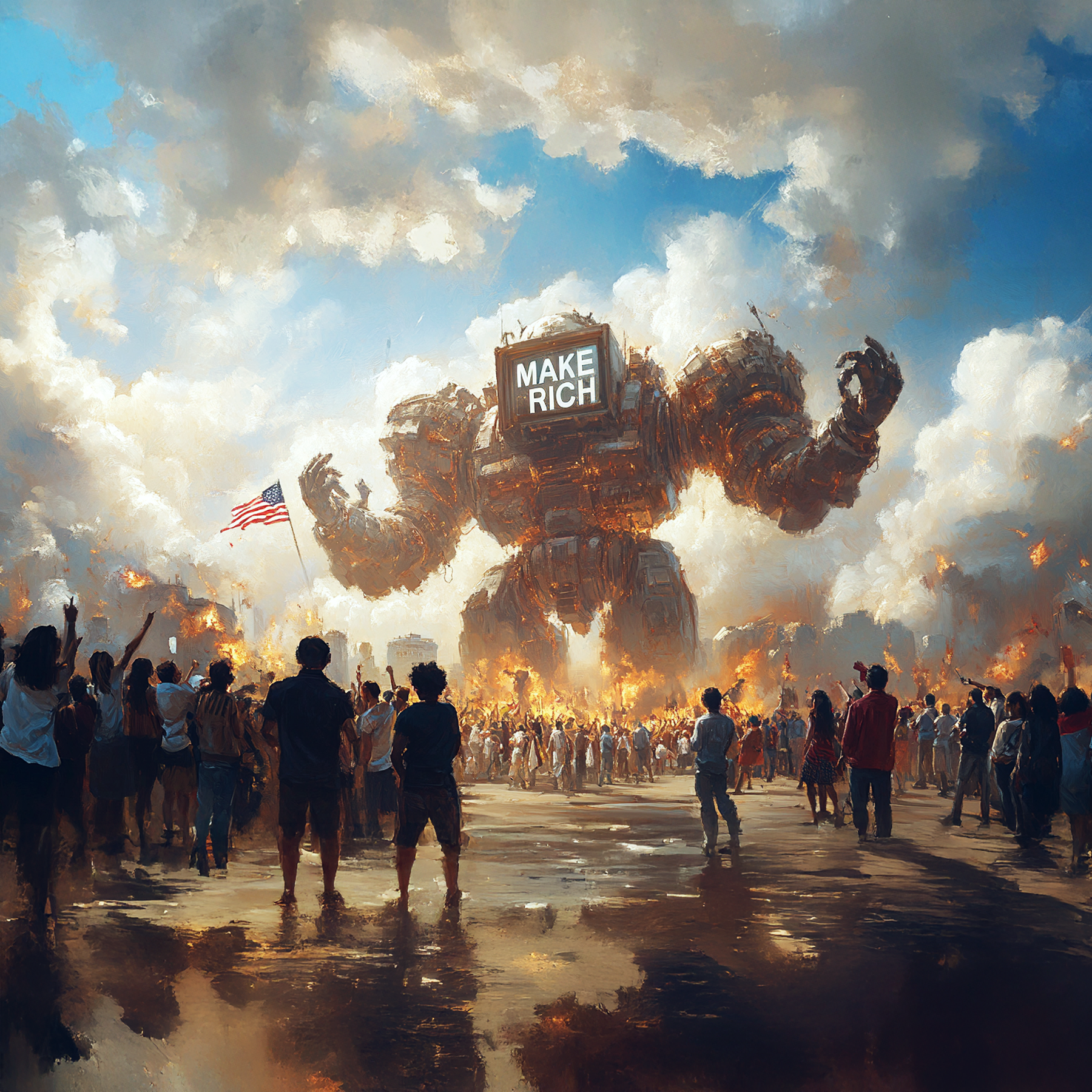
Ethics as Critical Inquiry
Make Rich Machine Can Take a Fight
Ethics opens our eyes and aligns our brains toward the creation of a better reality. Those who engage with it know that conforming to powerful, nonsensical forces of oppression is never an option. But they are only one group of the population.
As we fight some of the biggest battles of our digital civilization, some humans engage, others just watch. The Make Rich machine may look like it’s toppling down… and yet, it may stand forever.
This codification was done through multiple prompts and remixes using Midjourney V6.1, in collaboration with a custom-trained GPT. The image was finalized in Adobe Photoshop, where key areas were expanded, and adjustments were made to color balance and contrast.
The scene is charged with tension: a crumbling digital temple, collapsing under the weight of its own lies, but still dangerous, still standing, still humming with the illusion of relevance.
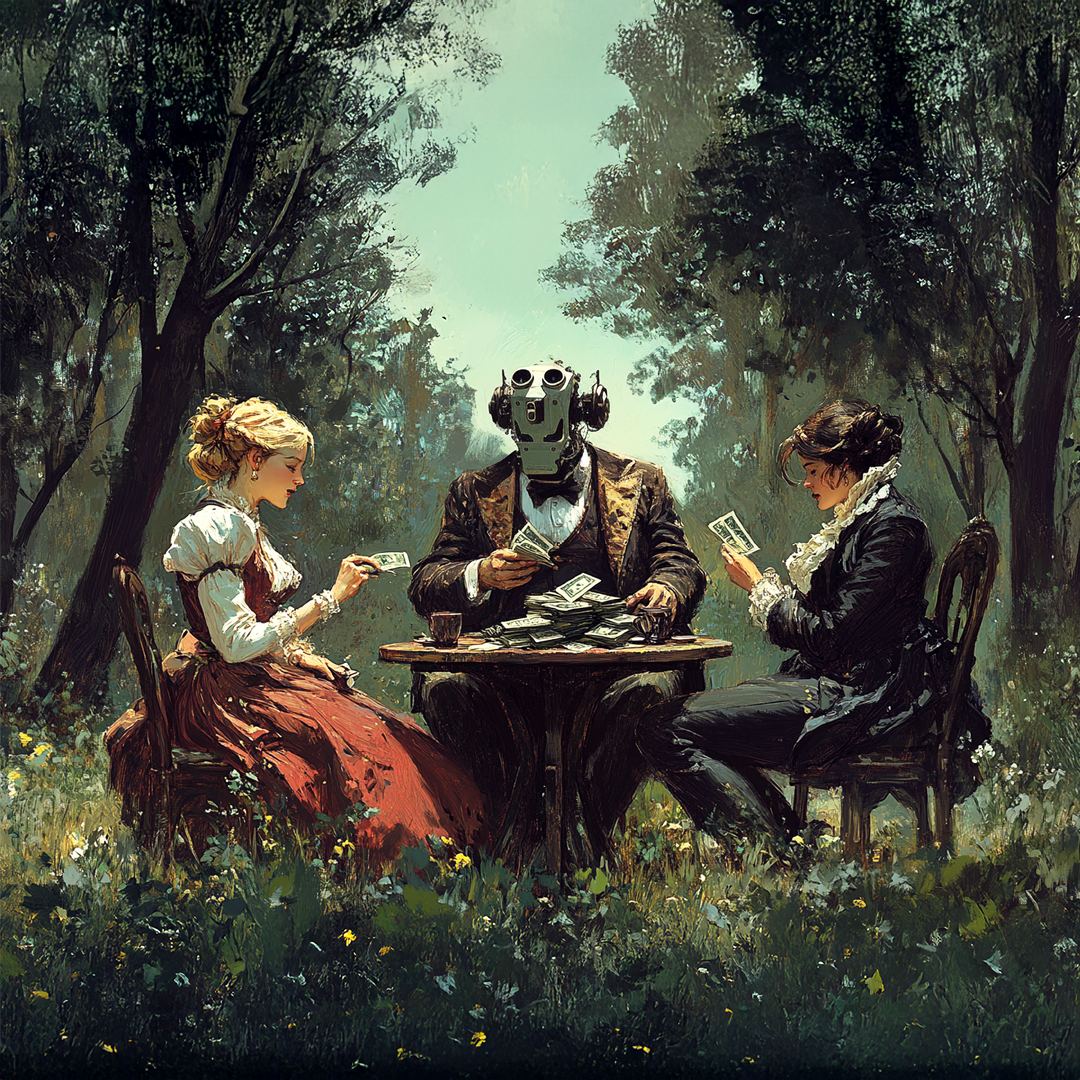
Mediation
I Can Provide the Best Human Connection Available in the Market
On a quaint and beautiful afternoon, two friends use their digital personas to engage in an amusing intellectual game. The place is timeless and classy, and everyone looks the part. A trusted mediator elegantly facilitates this encounter, conveniently controlling their interactions while making a profit from its much-needed service.
The mediator appears humanoid (refined, composed) as it is ultimately made in the image of those who own it. Its role is invisible and decisive, shaping what can be said, and how it will feel.
This codification was done through multiple prompts and remixes using Midjourney V6.1, in collaboration with a custom-trained GPT. The final composition was completed in Adobe Photoshop, with expanded visual areas and fine-tuned color balance and contrast. The classical painting style, with a deliberate glow and soft light, reinforces the timelessness and casual nature of the interaction, while masking the architecture of control embedded within it.
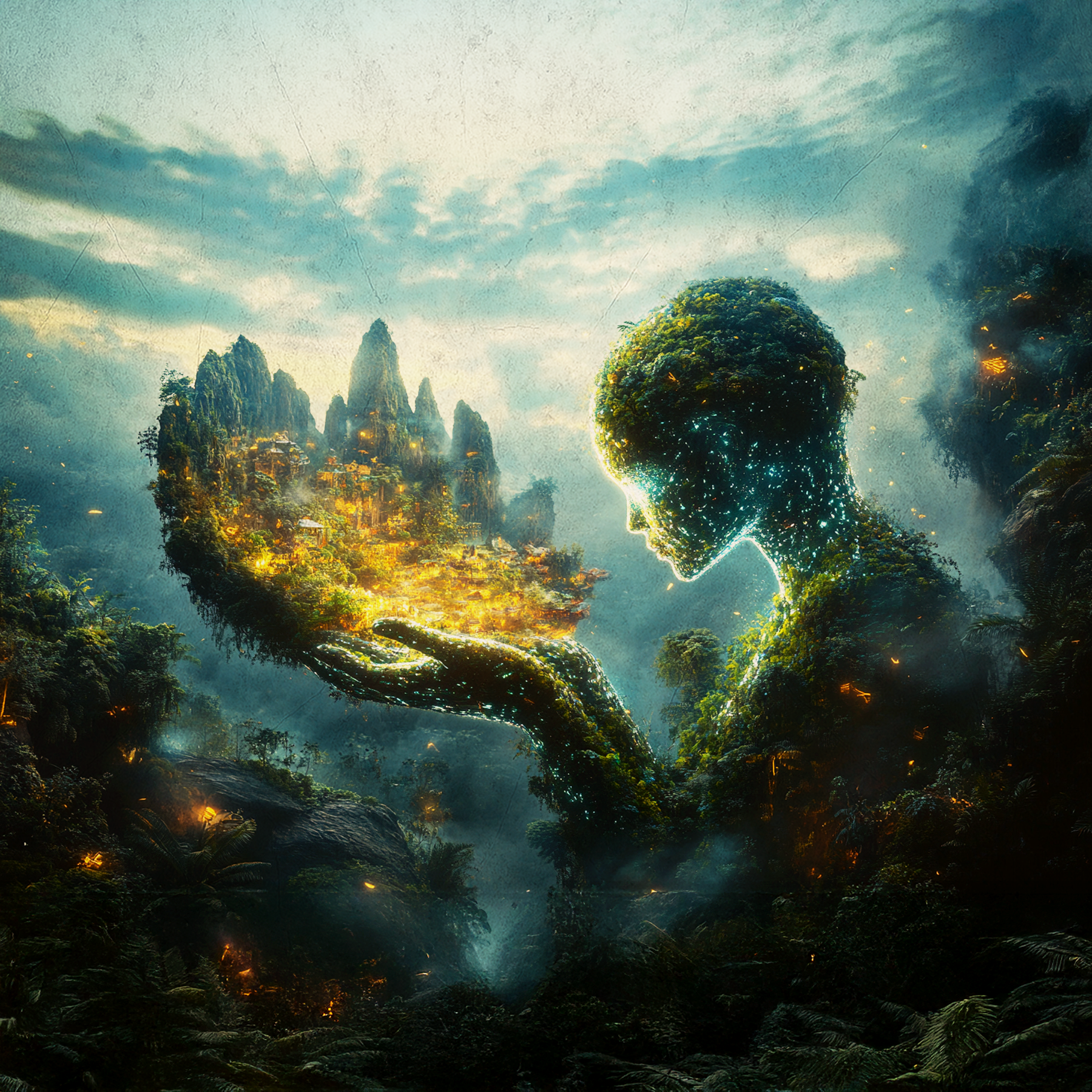
Ethics as care
A Beautiful Yet Isolated Community
The future may rely not on the internet, but on intranets, networks of care and intention. Within these small, data-sovereign communities, everyone looks after one another. Their collective consciousness has given life to a powerful custom-trained AI platform designed to monitor and respond to the wellbeing of each member.
It’s a beautiful way of living, even if it means being isolated from the rest. Safety, meaning, and care replace exposure, noise, and surveillance. Ethics stops being a debate, becoming practice.
This codification was created through multiple prompts and remixes using Midjourney V6.1, in collaboration with a custom-trained GPT. The image was finalized in Adobe Photoshop, where color balances were refined and certain visual areas expanded. A warm, soft aesthetic overlays the composition, reinforcing a sense of harmony and intentional seclusion.

Future Imagination
A Bridge of Knowledge Transfer
An old photograph reveals a reality that has been unfolding for some time: one in which the deceased and the living interact regularly, co-creating knowledge together. The future of imagination is shaped by dreams and data, by the traces we constantly leave behind, and by the systems designed to package and reanimate that data to keep us connected with those we’ve lost in the biological world.
In the new digital environment, the boundary between life and death begins to dissolve. Memory, computation, and imagination blur into one another, reshaping what it means to be human, and what it means to remain.
This codification was created through multiple prompts and remixes using Midjourney V6.1, in collaboration with a custom-trained GPT. The final image was completed in Adobe Photoshop, with expanded areas, refined color balances and contrast, and a timeless old-photograph texture to anchor the speculative in the familiar.
Educators, students, and practitioners are invited to explore these contributions not only as artistic works, but also as starting points for dialogue on ethics and technology. You are welcome to use and share them in your own learning contexts.
The works have been published under a Creative Commons licence (CC BY-SA-NC).
Further resources: